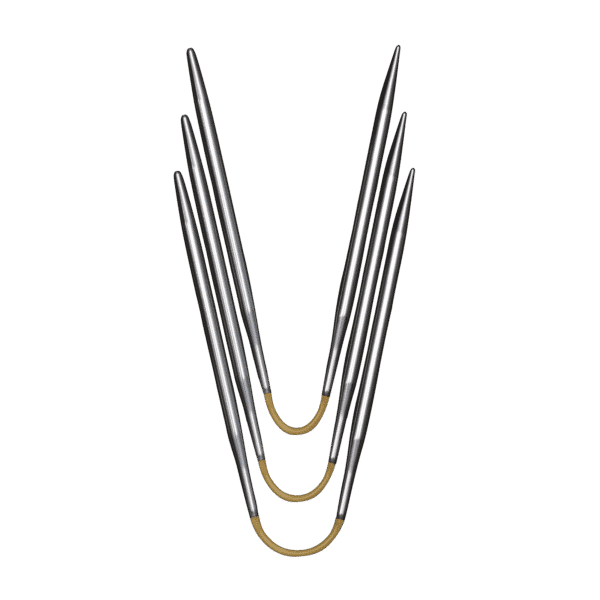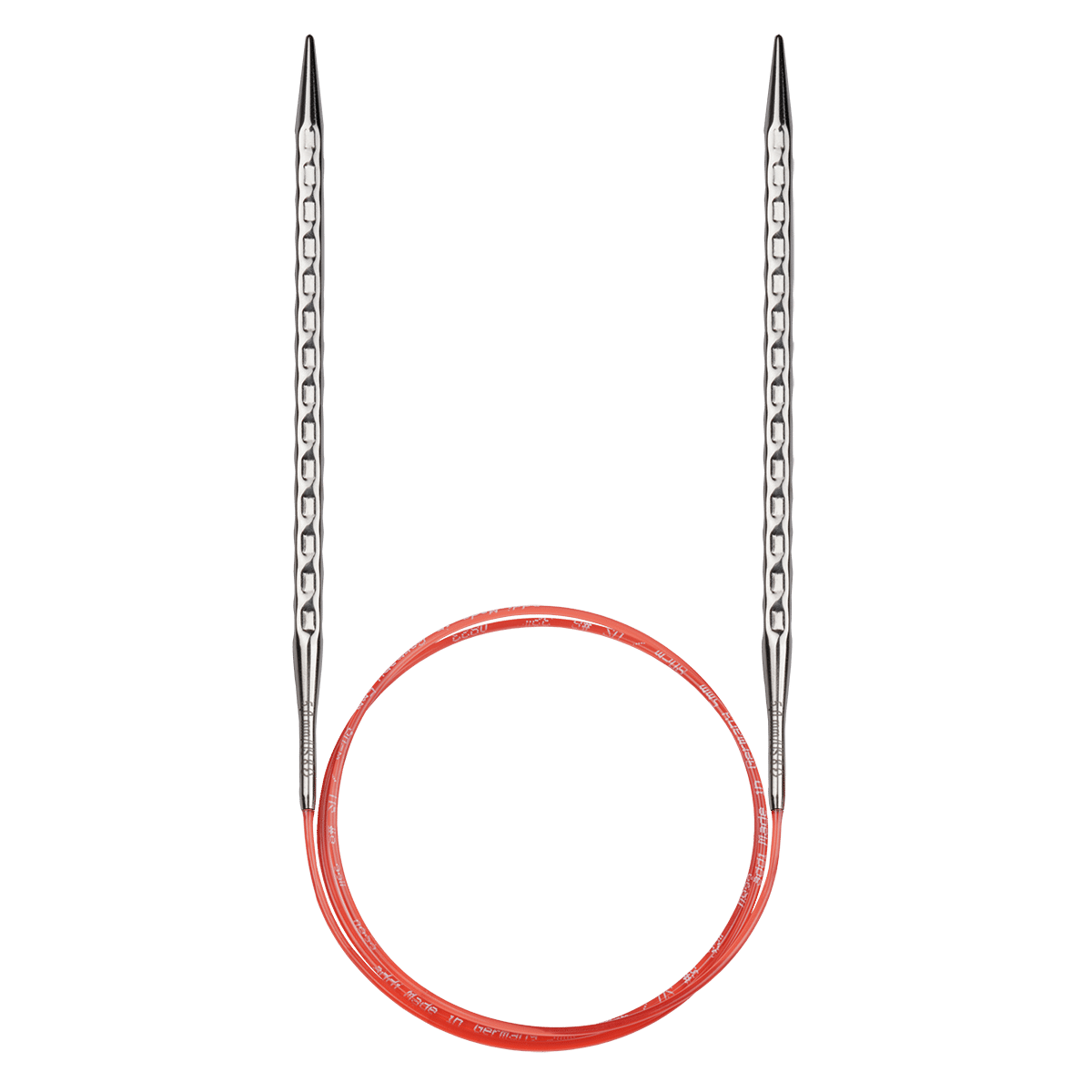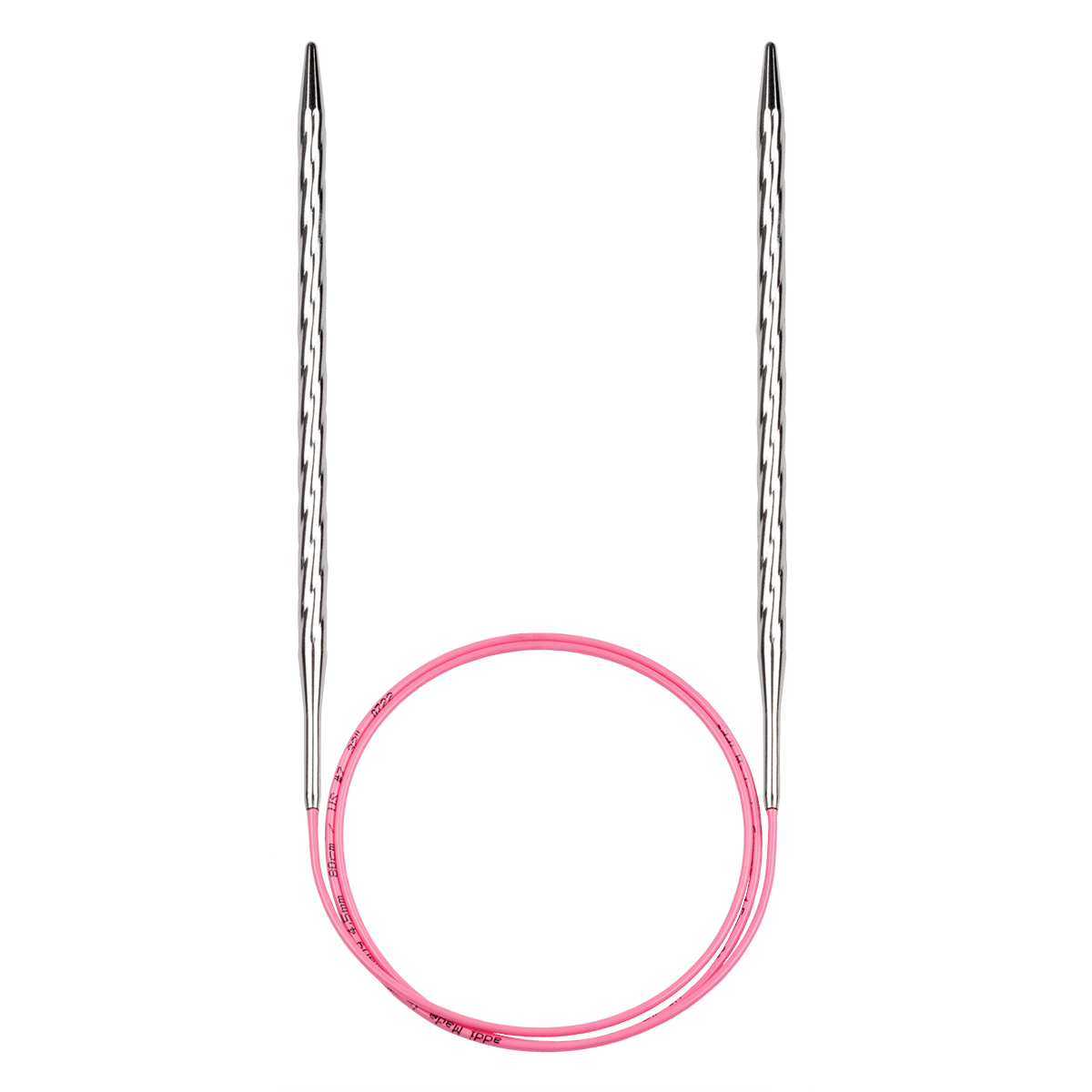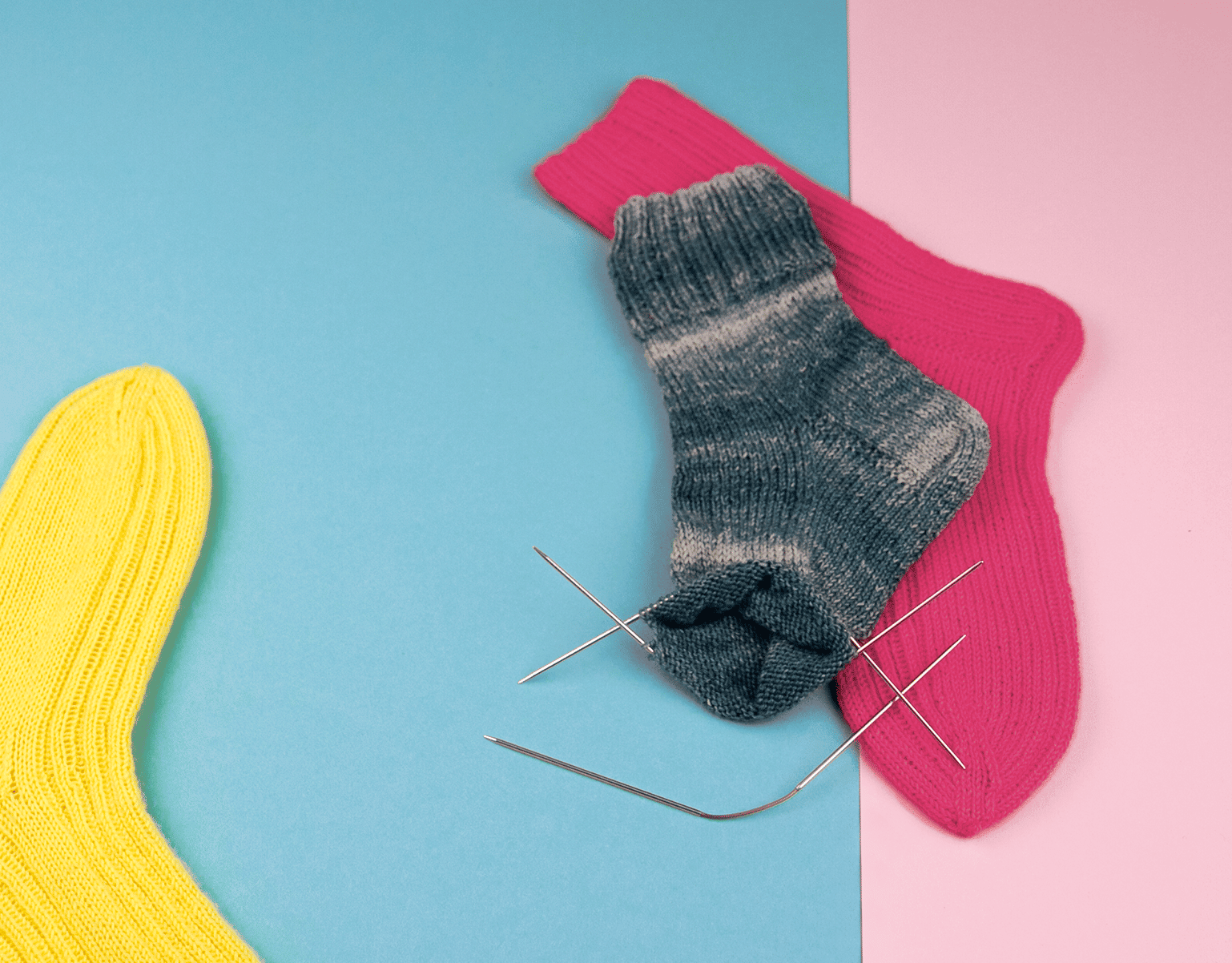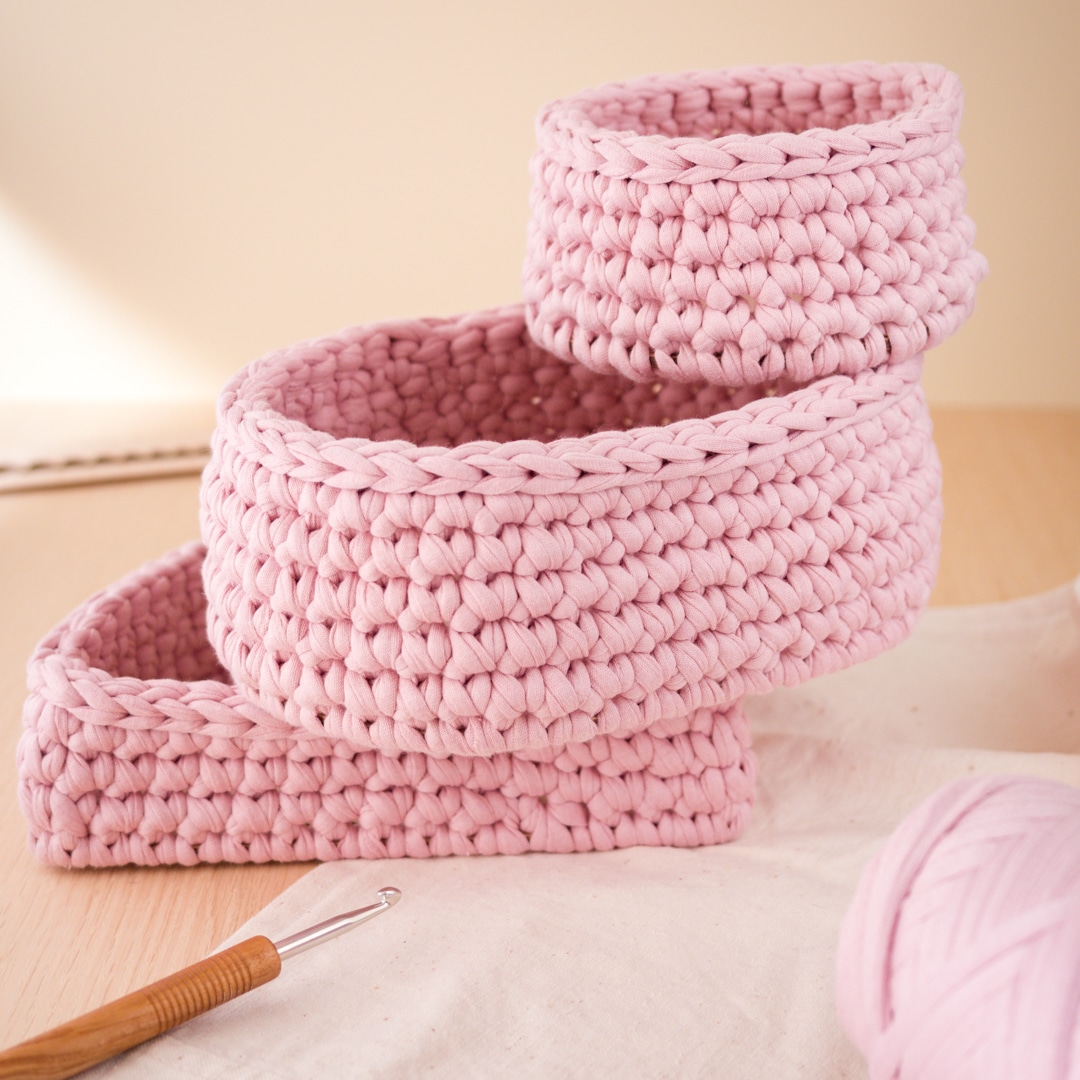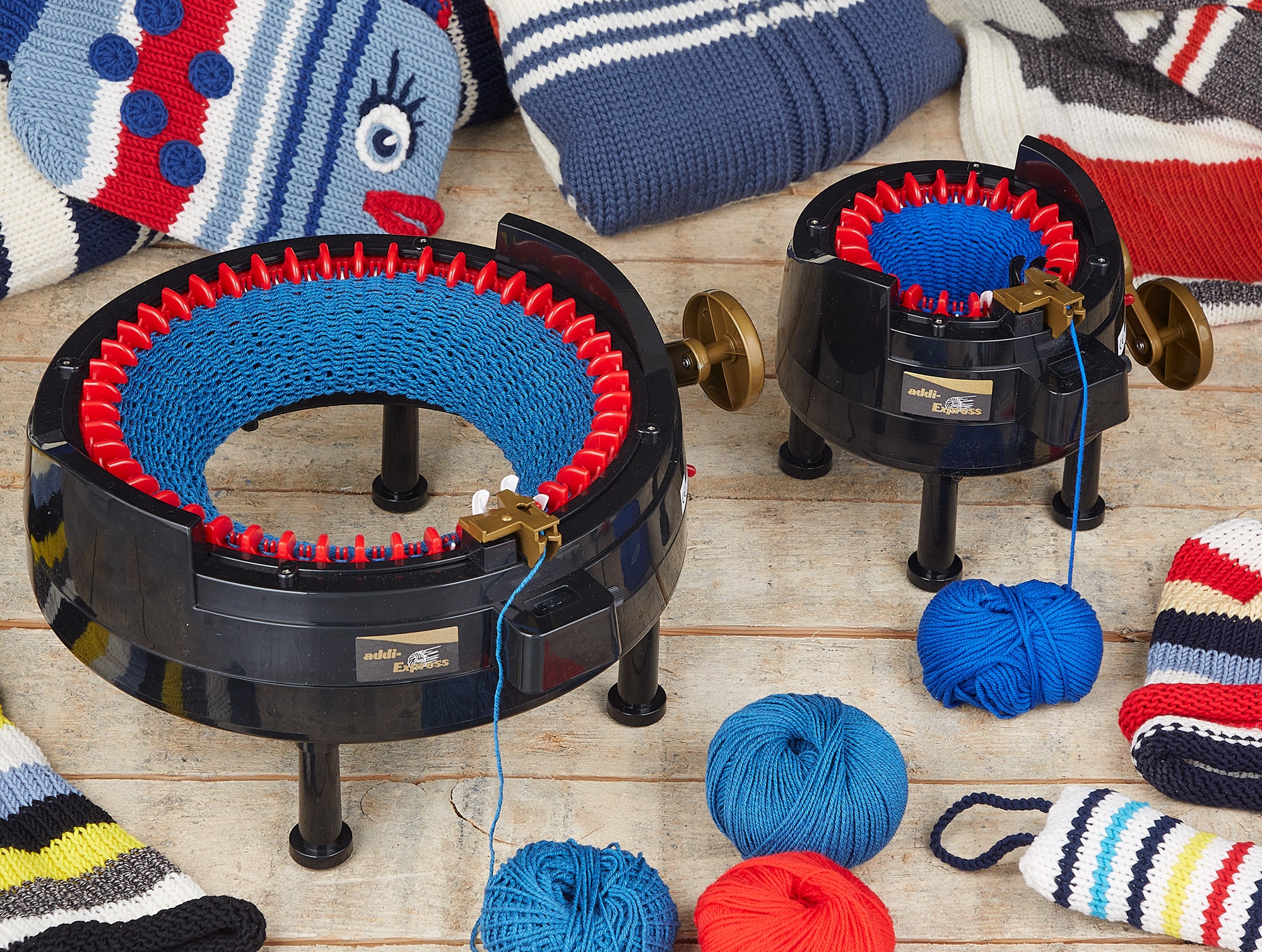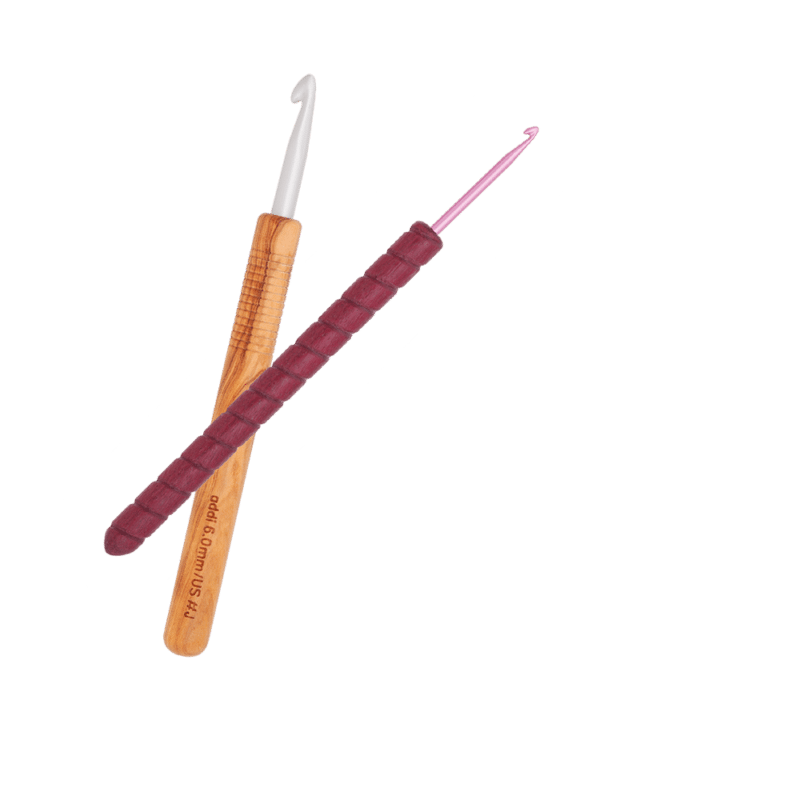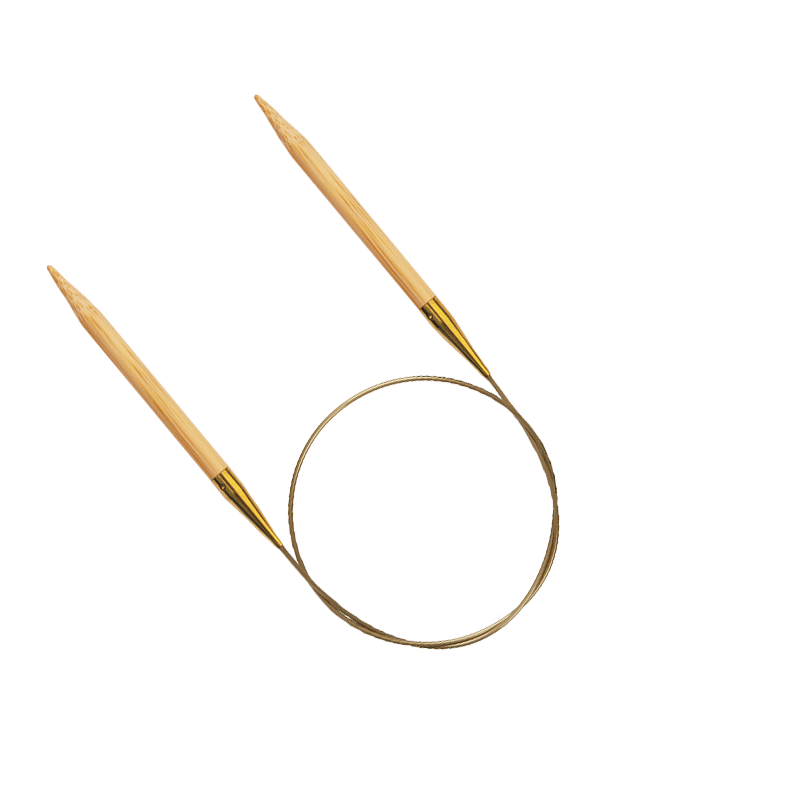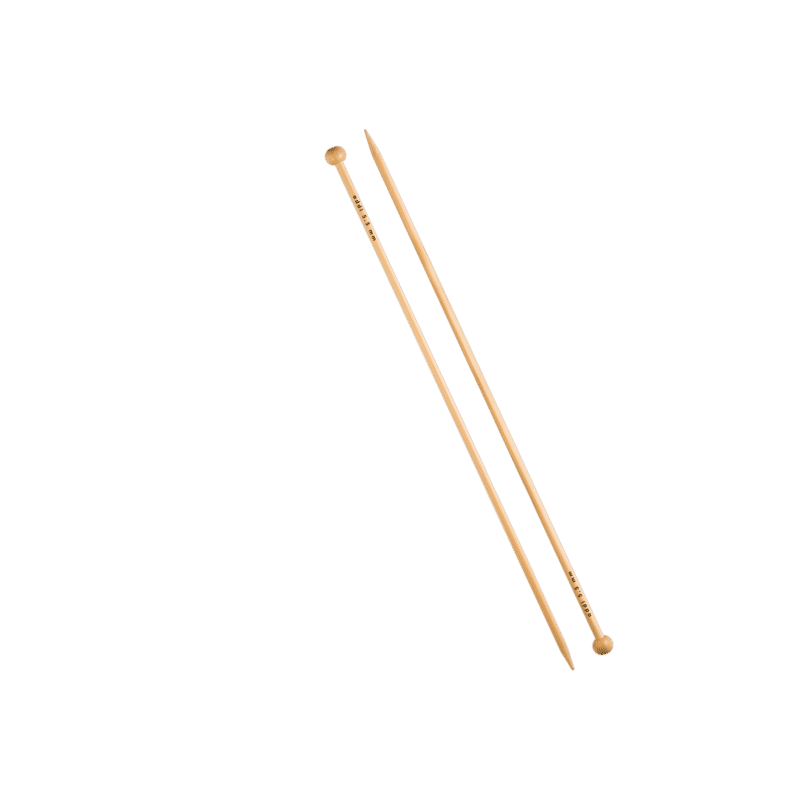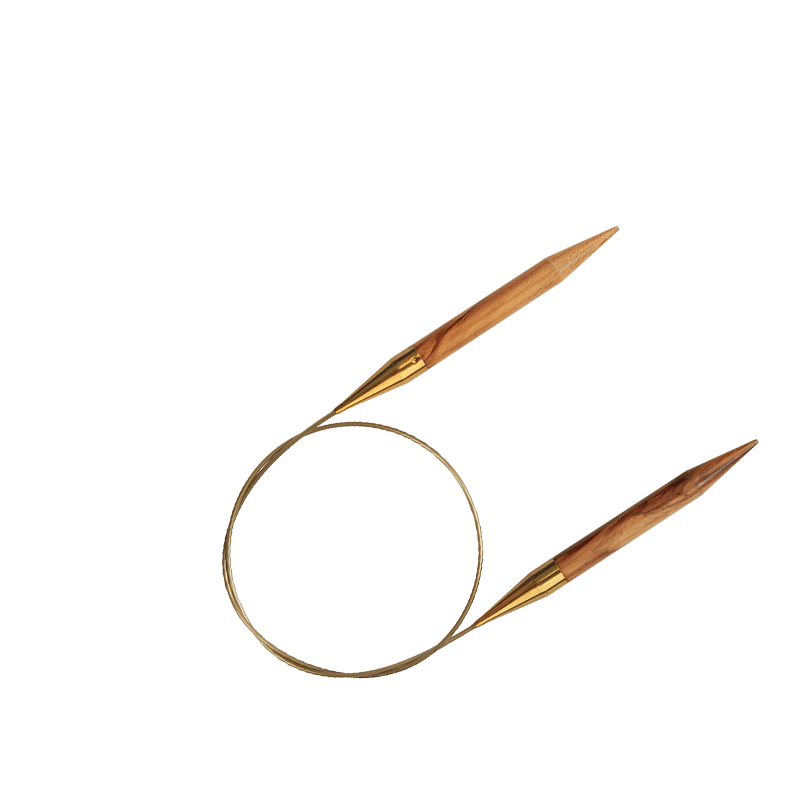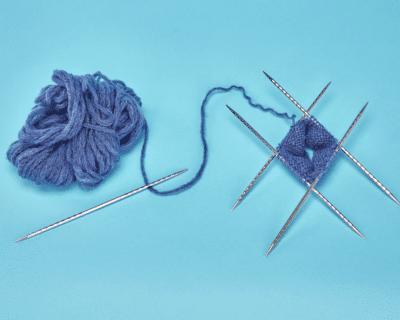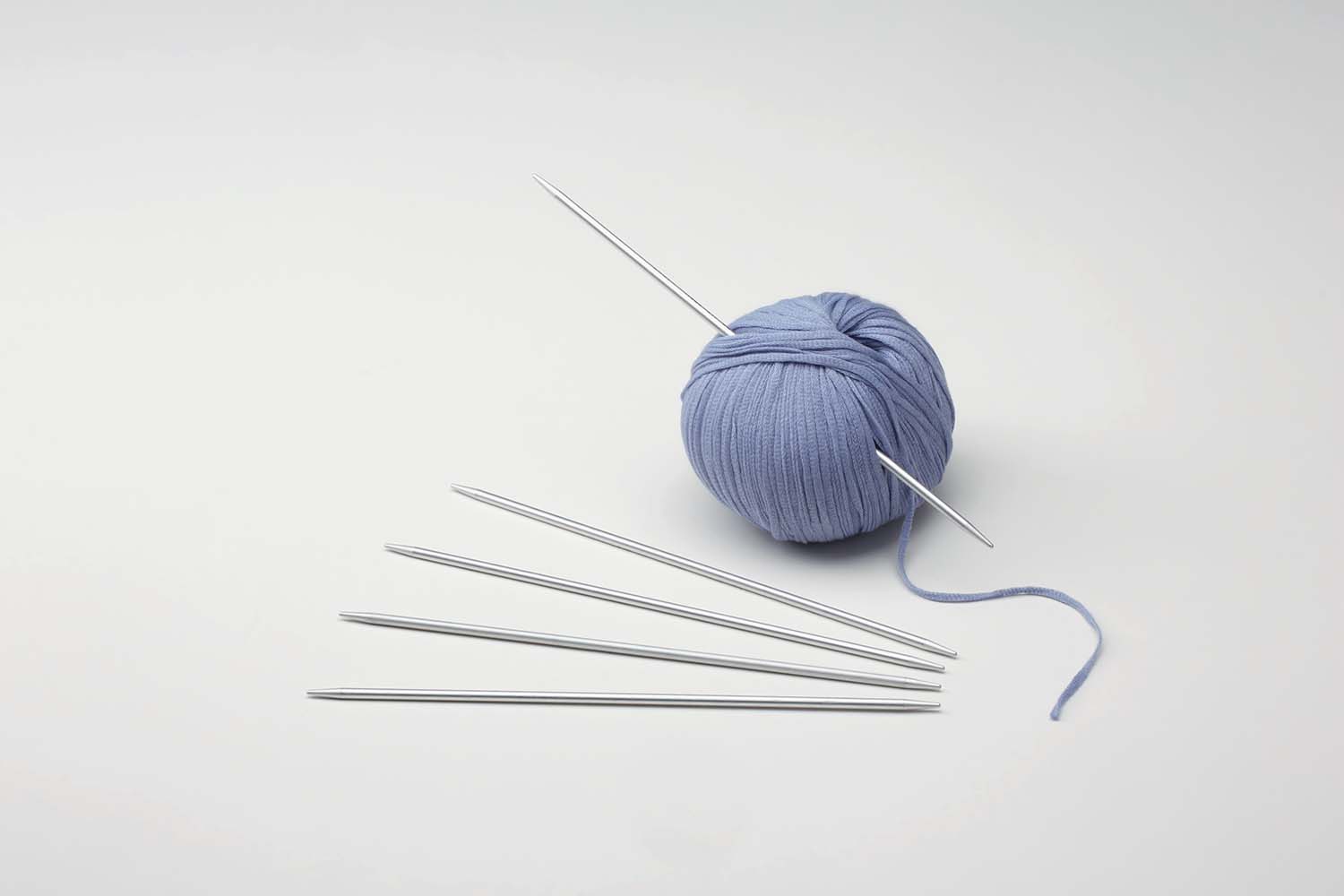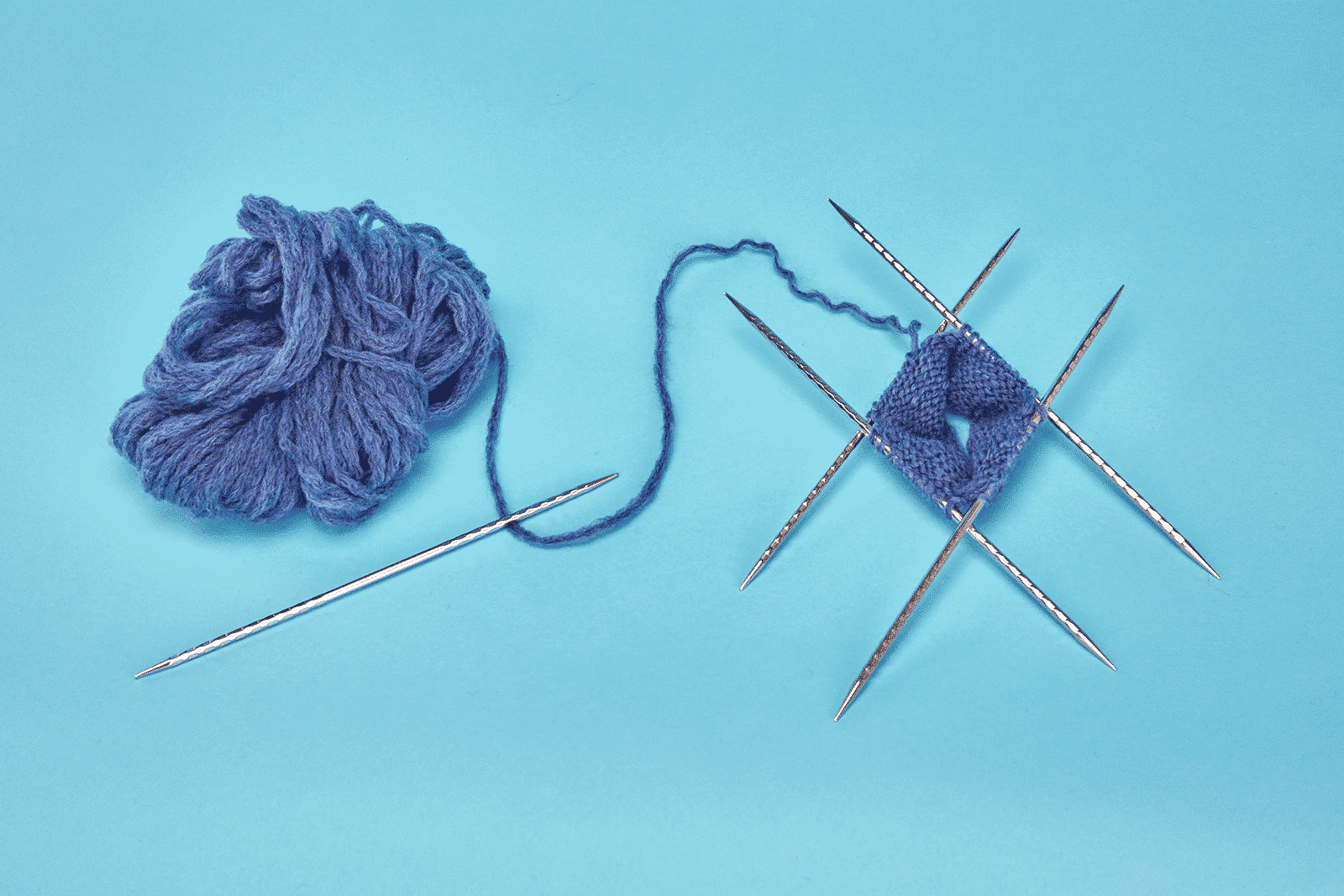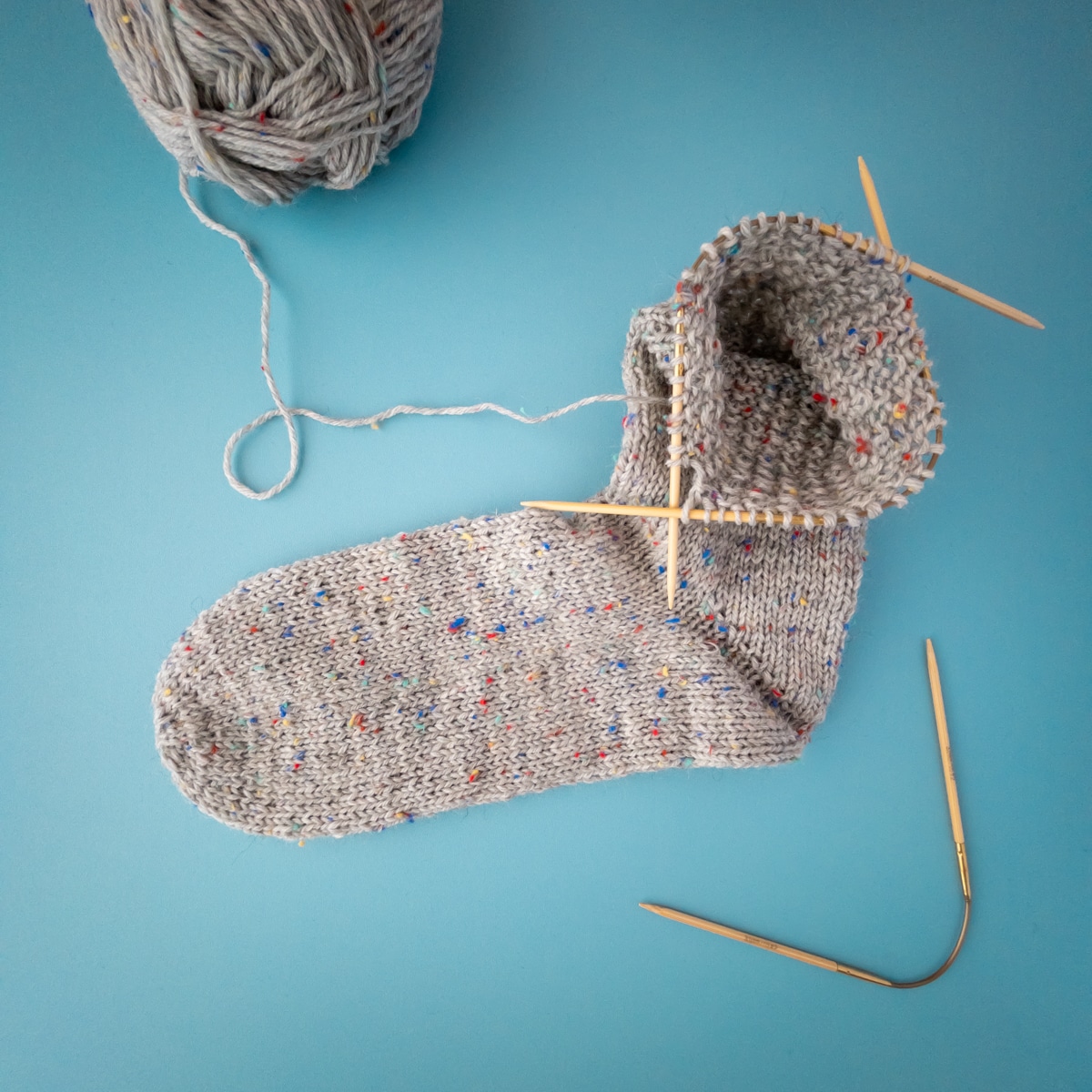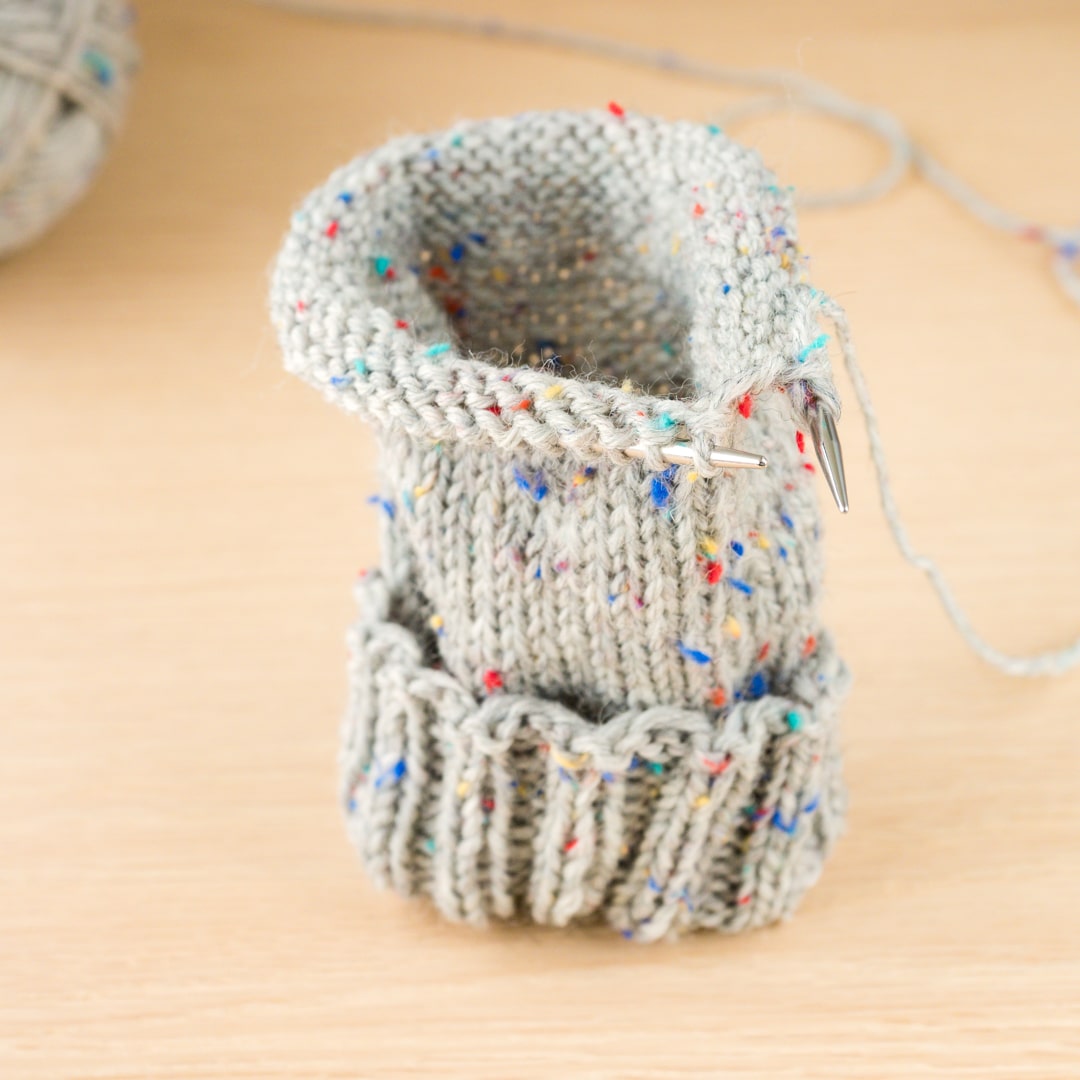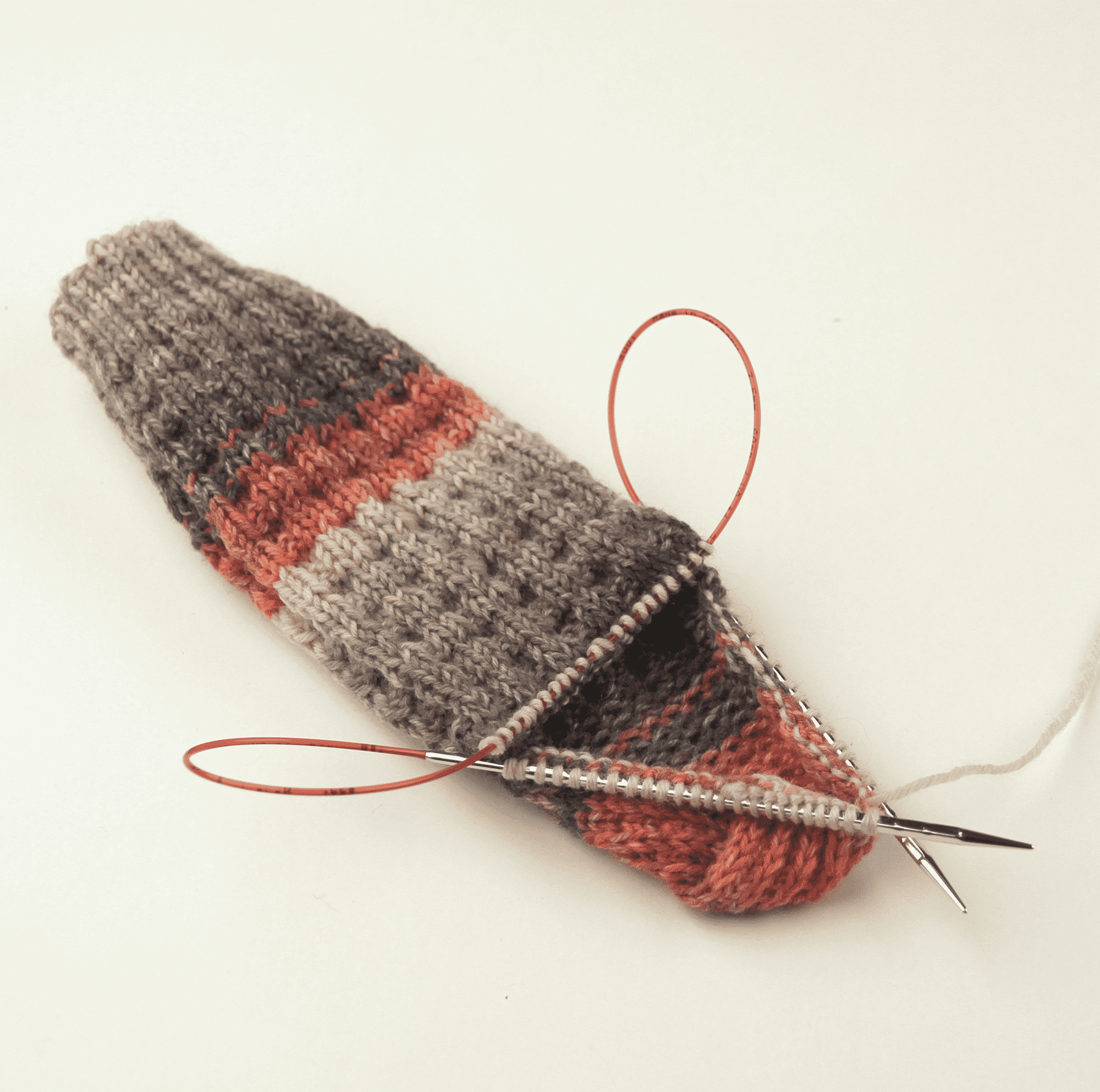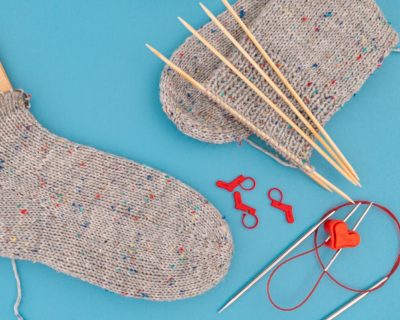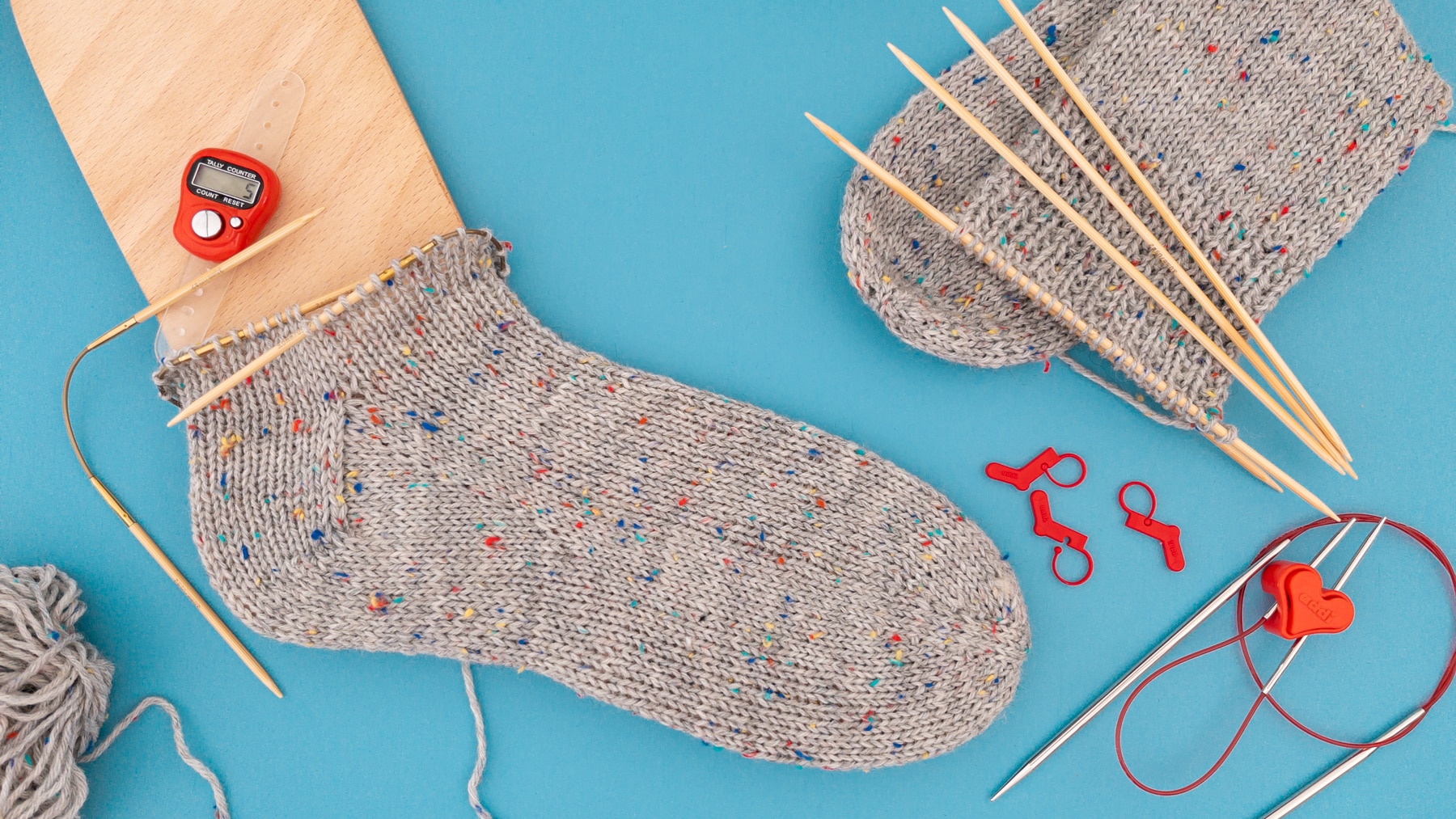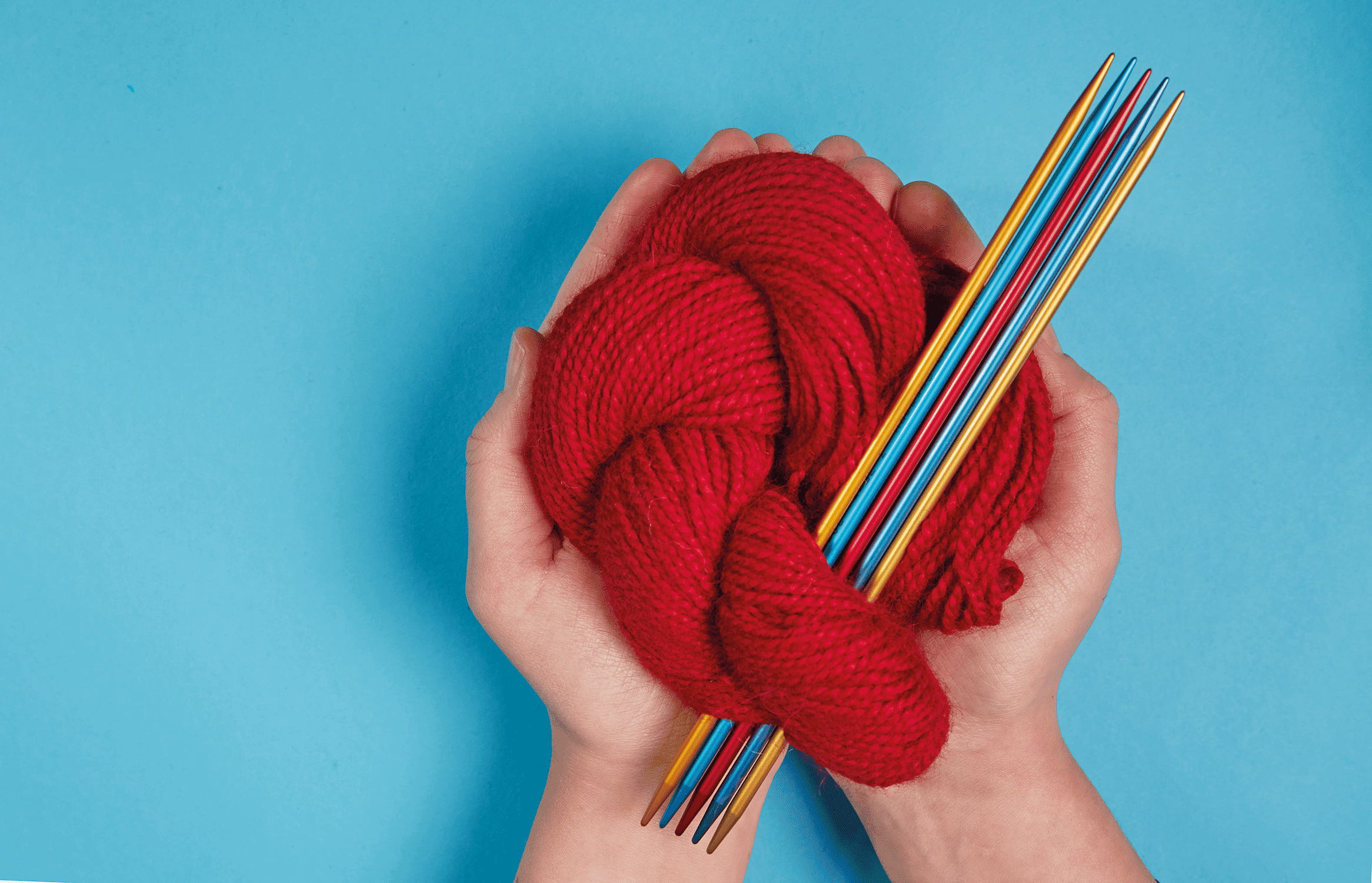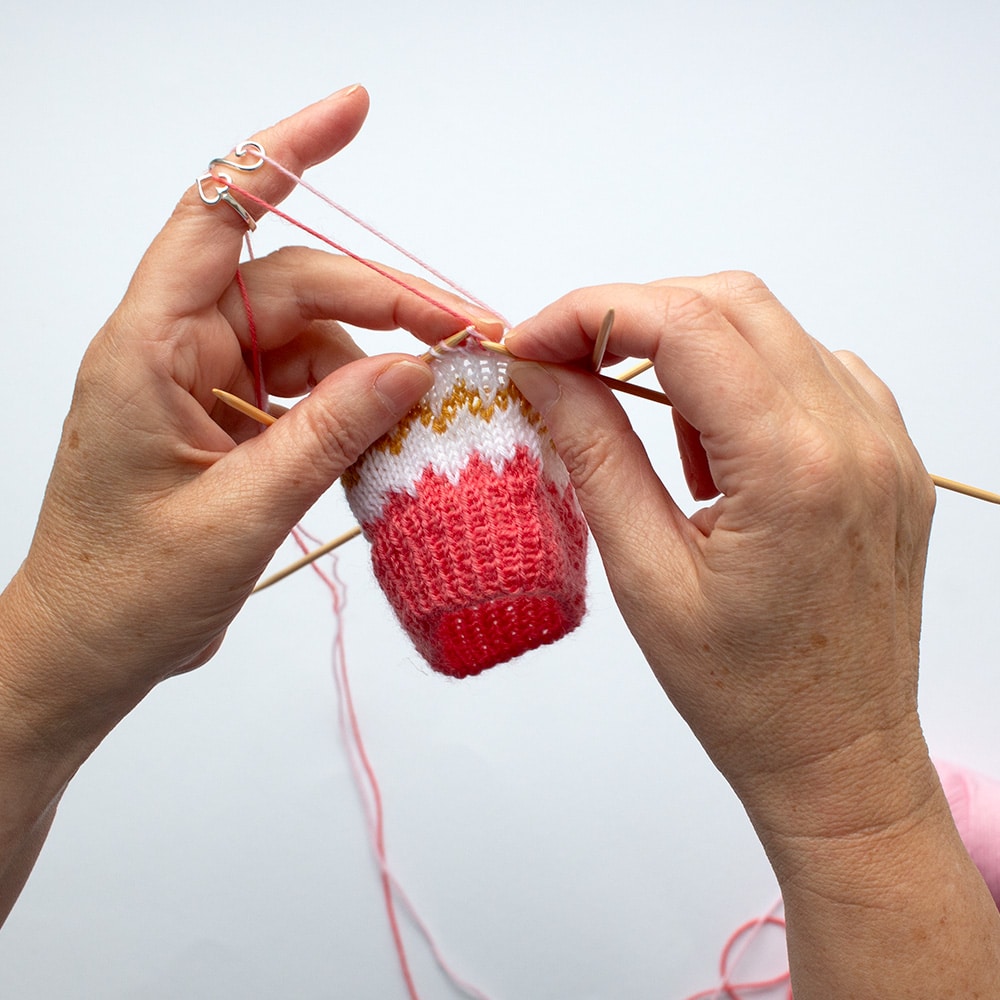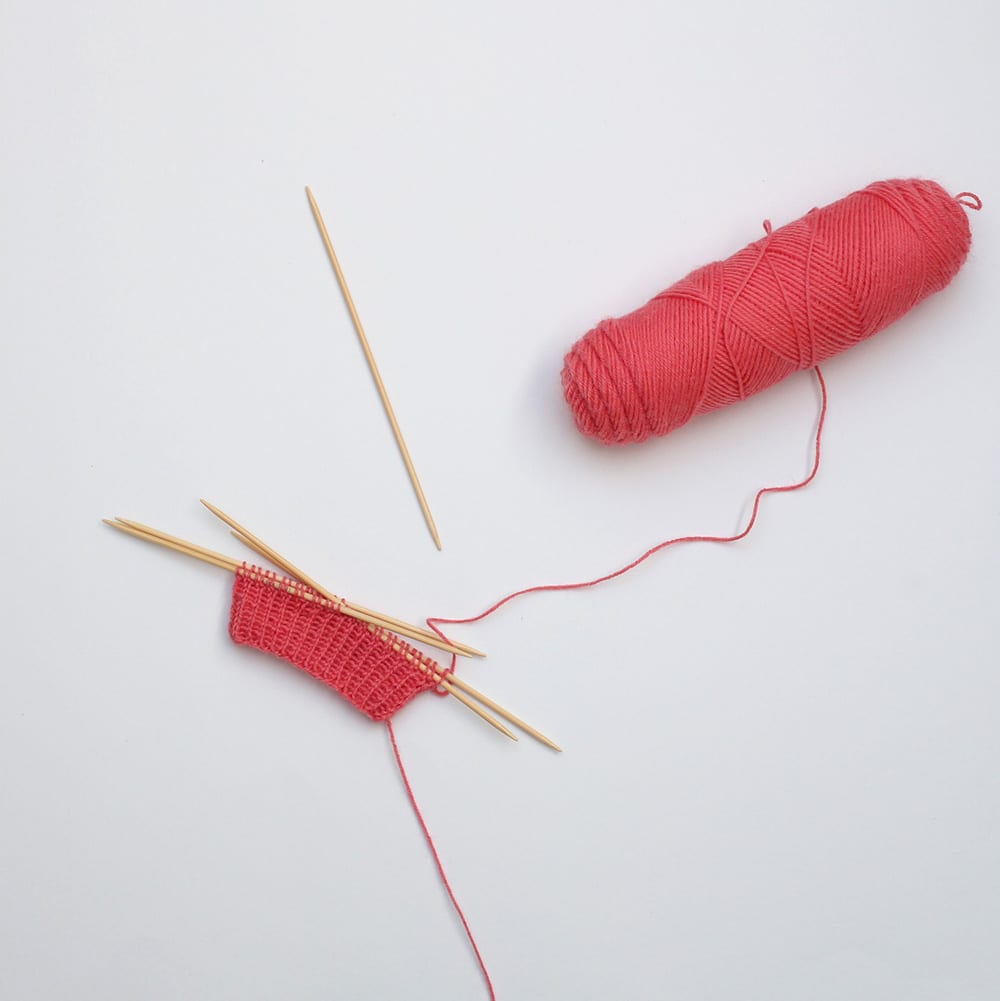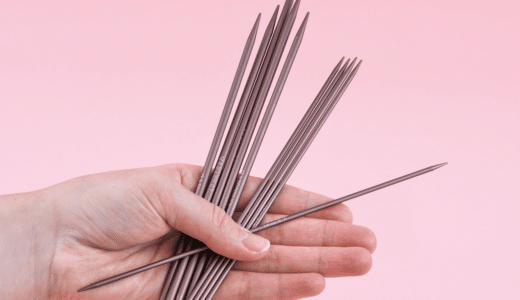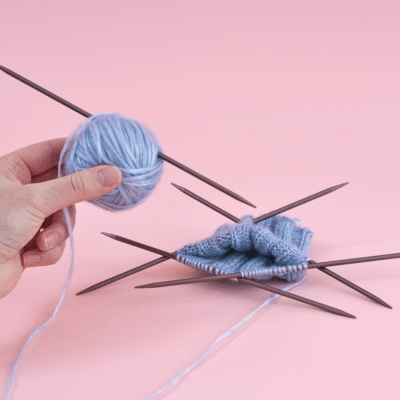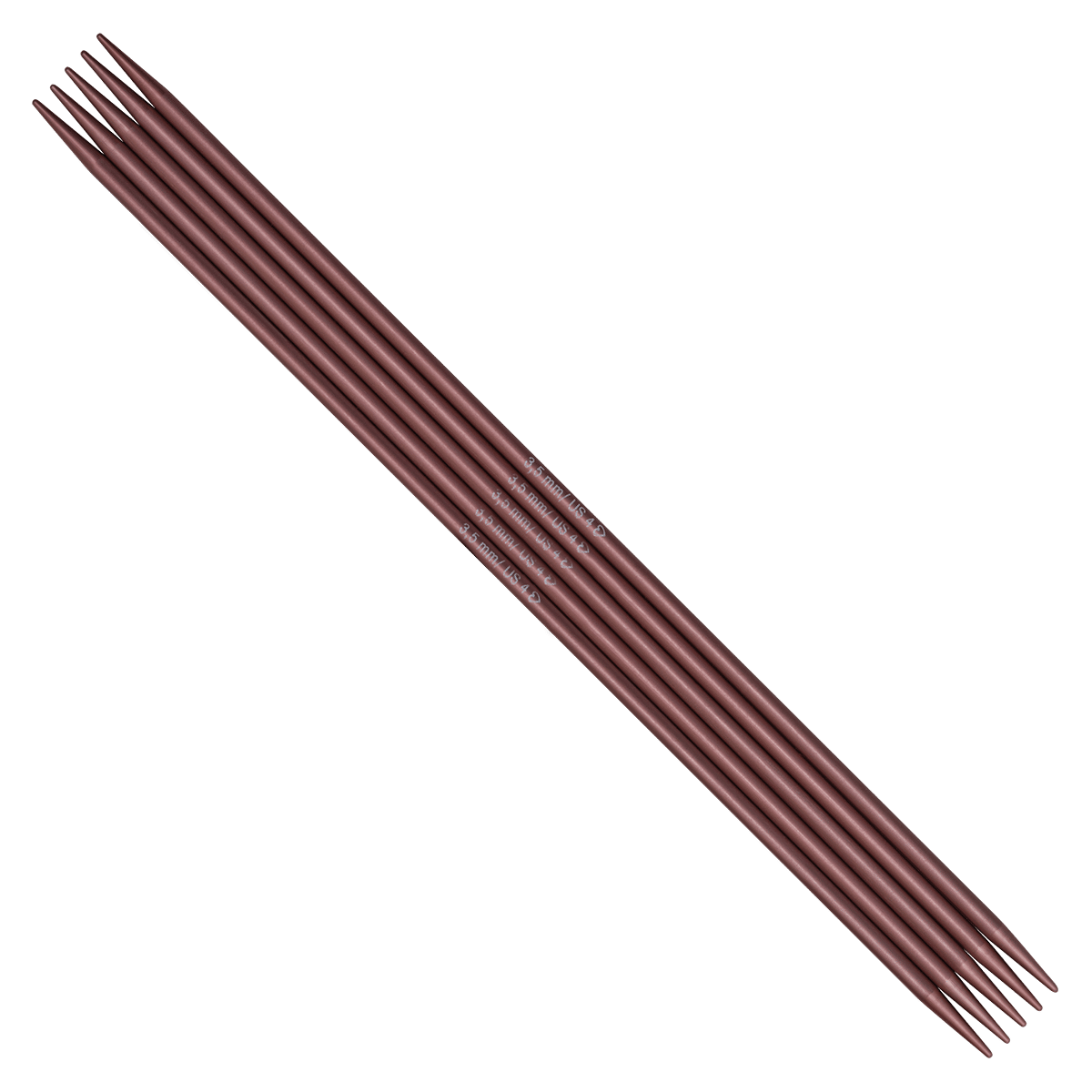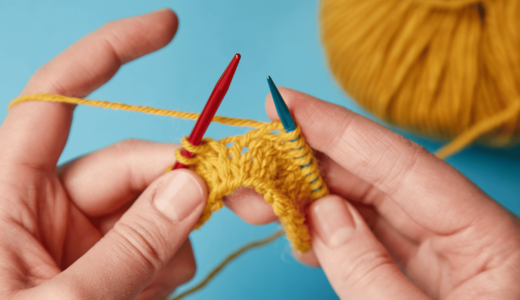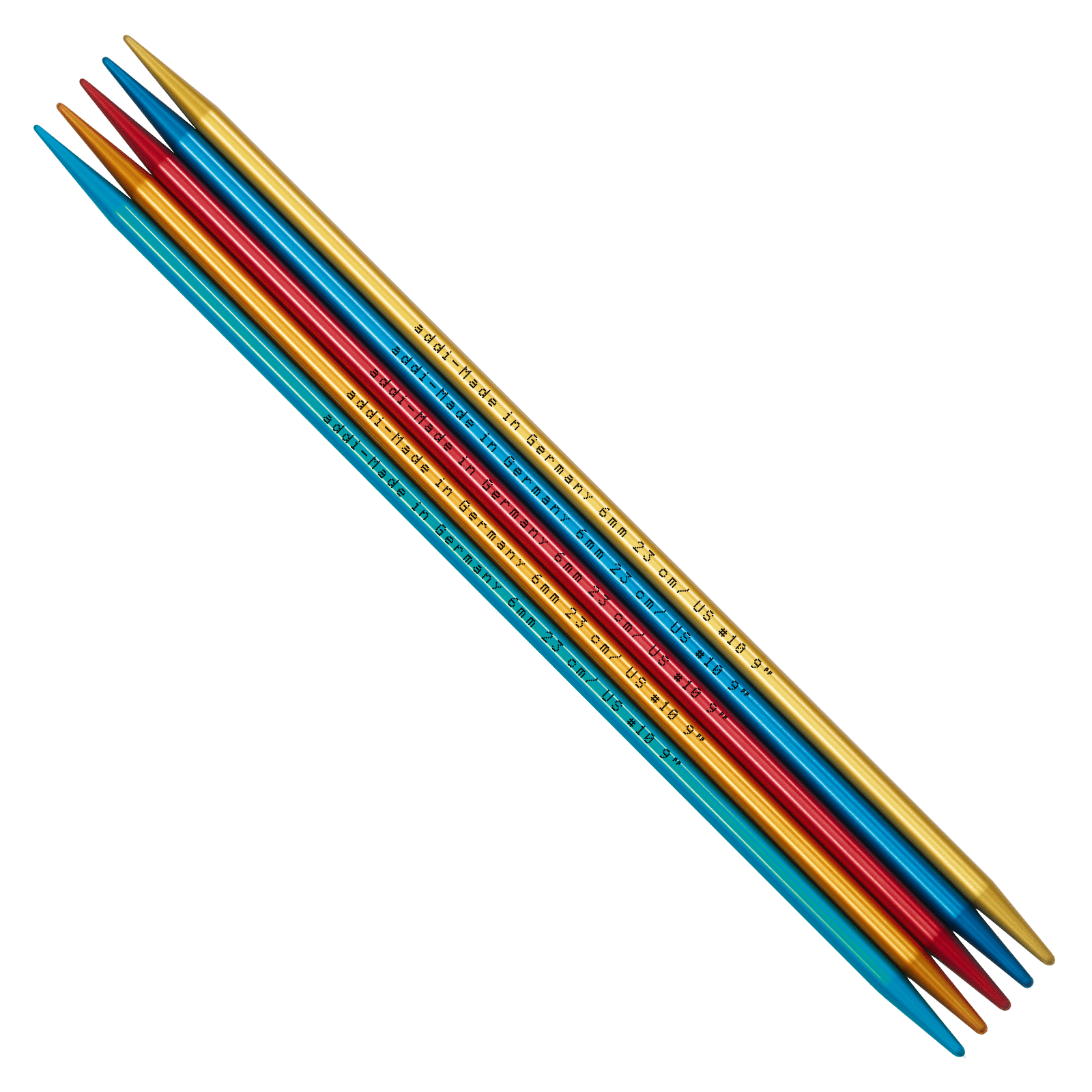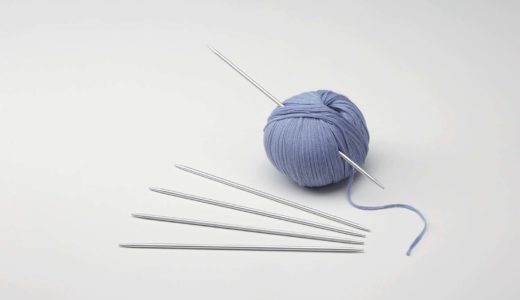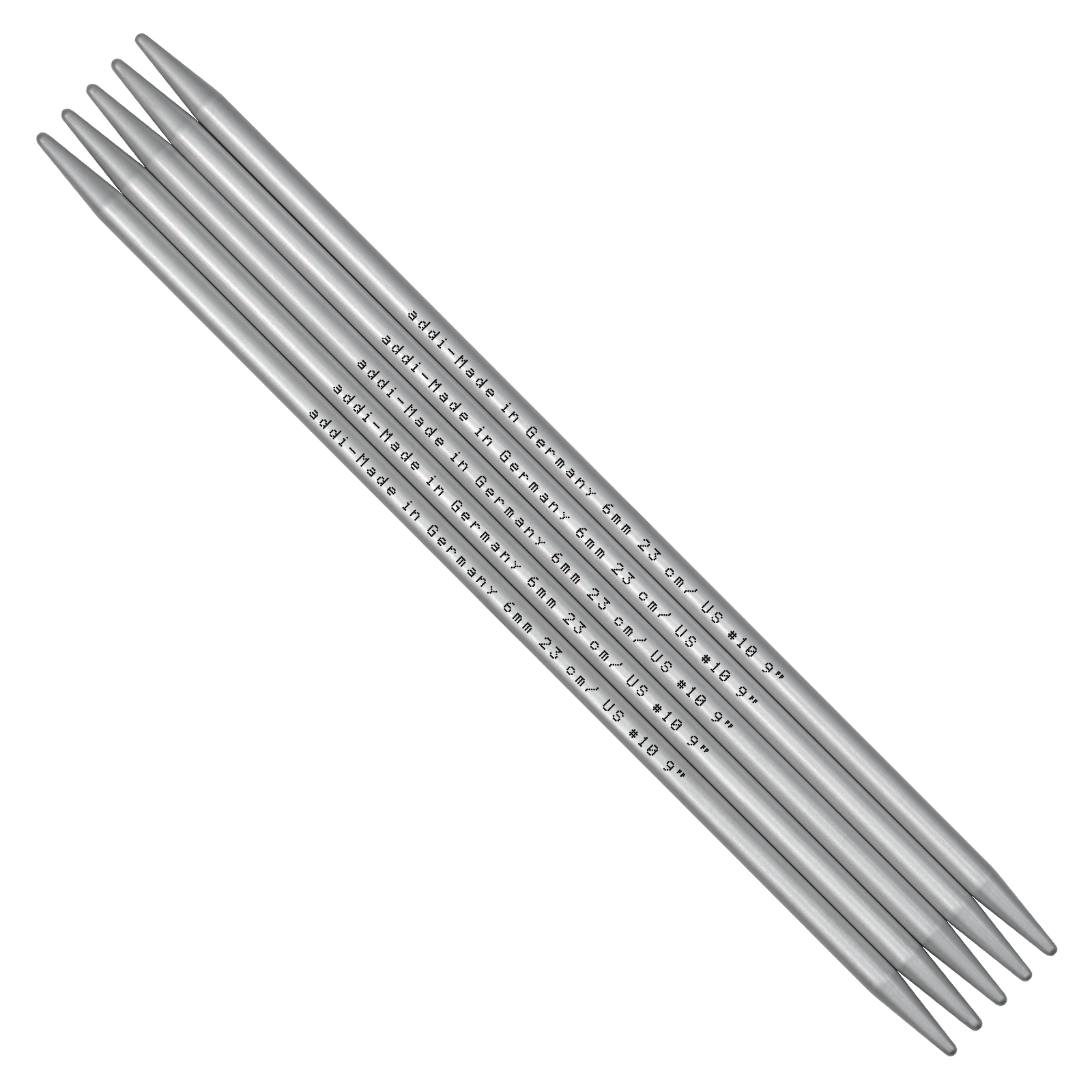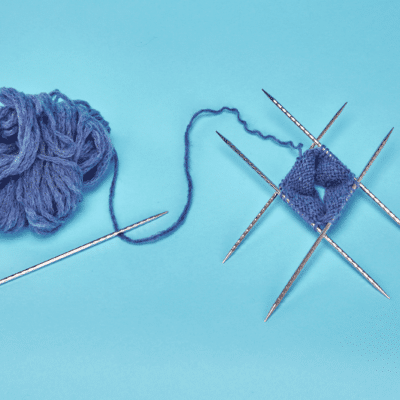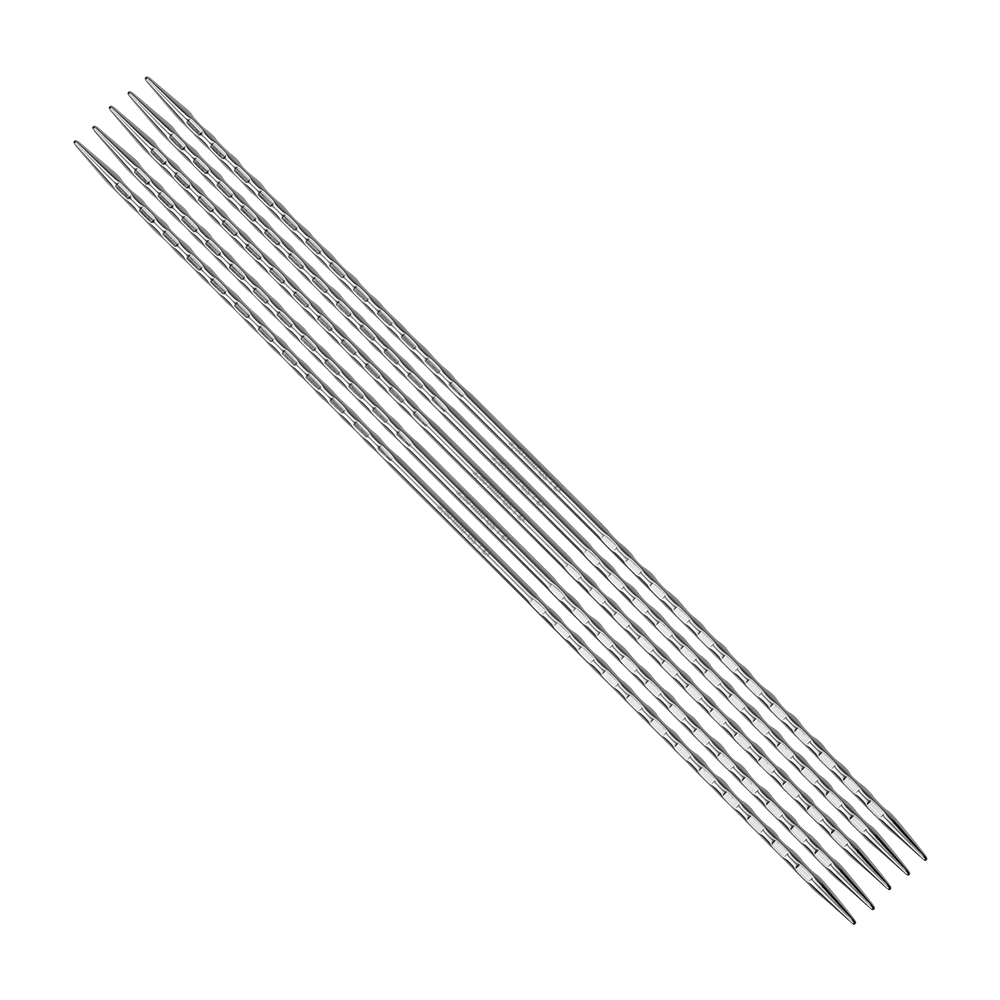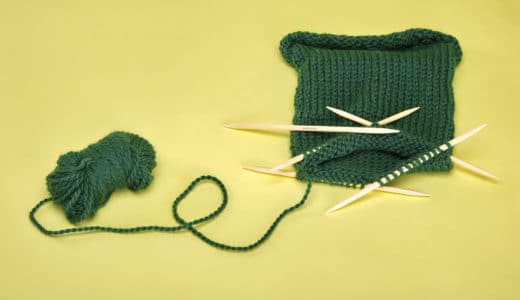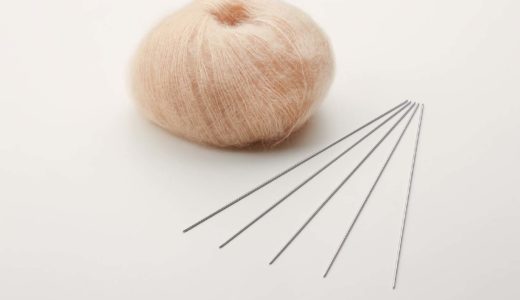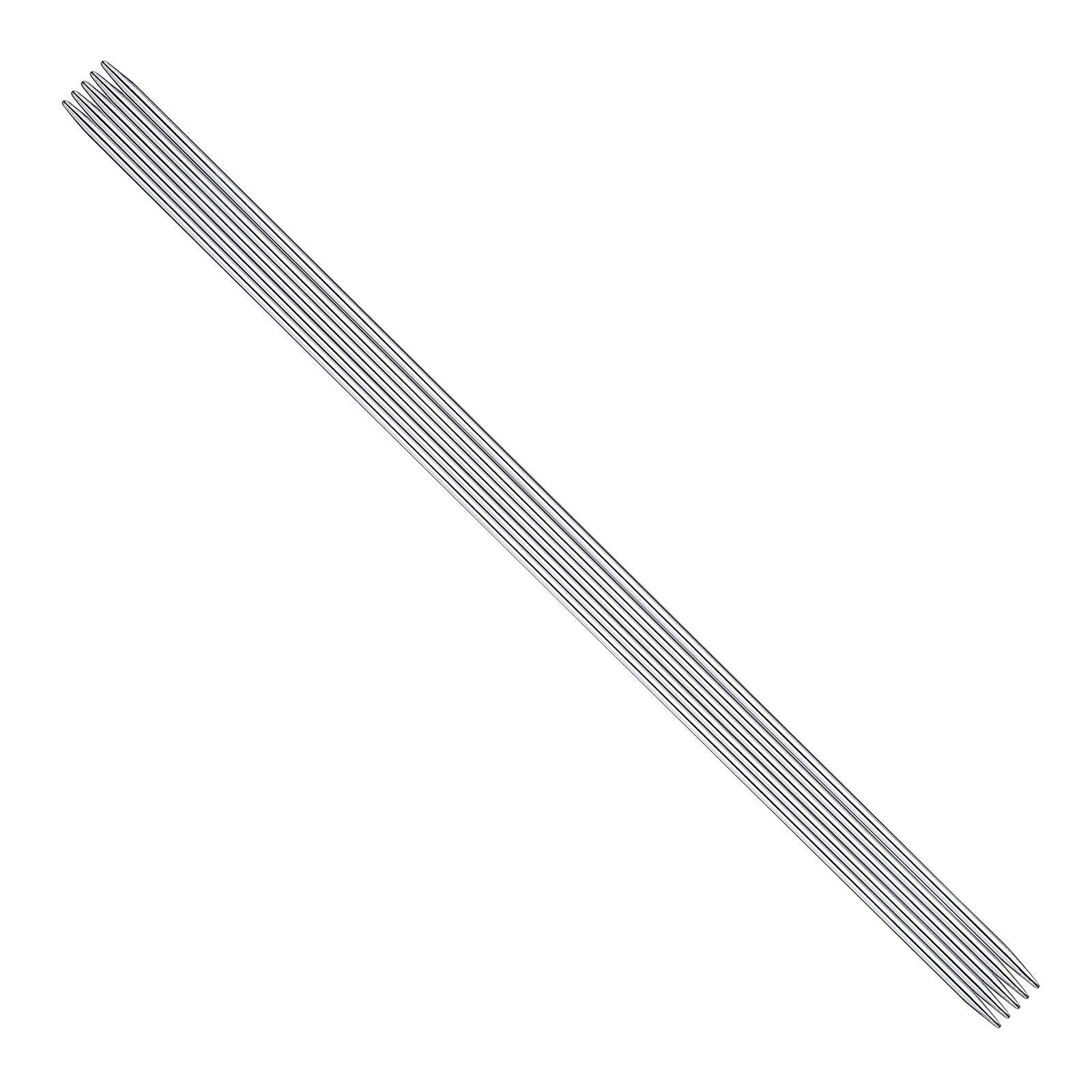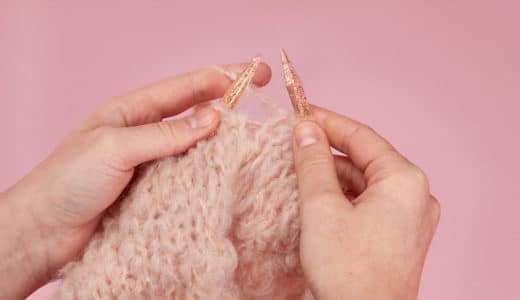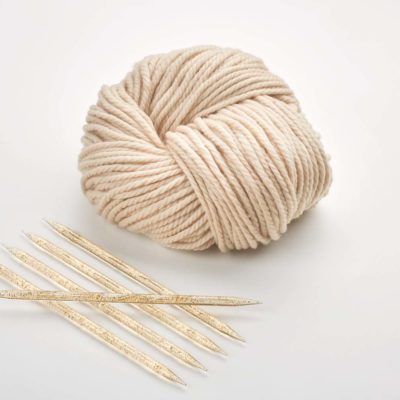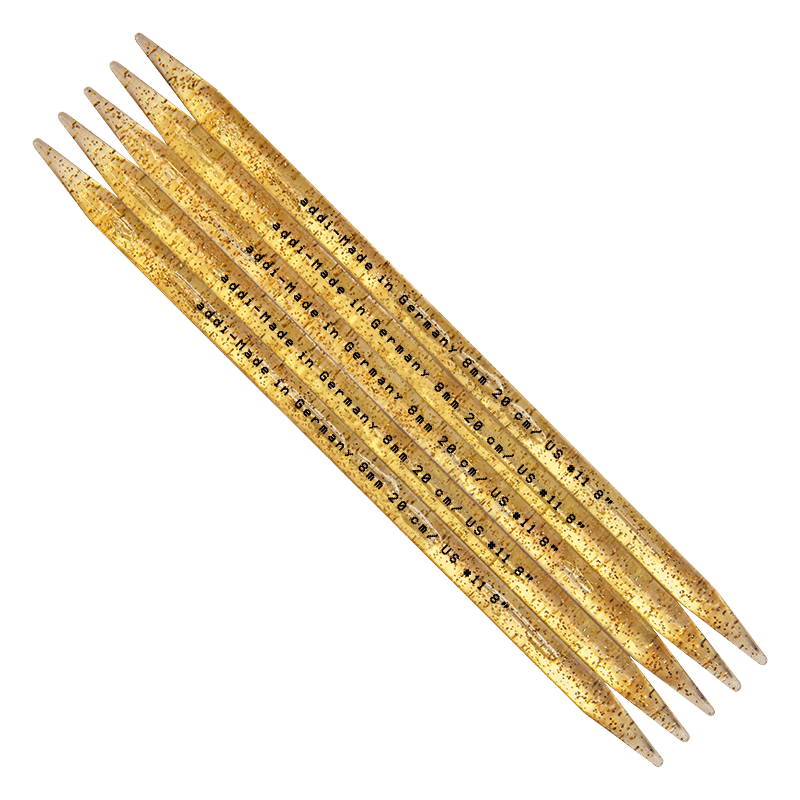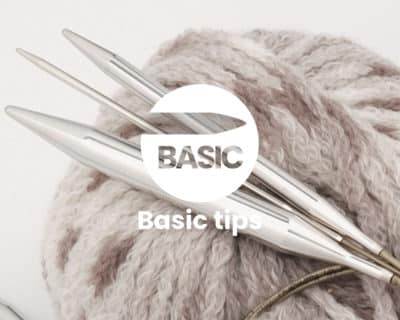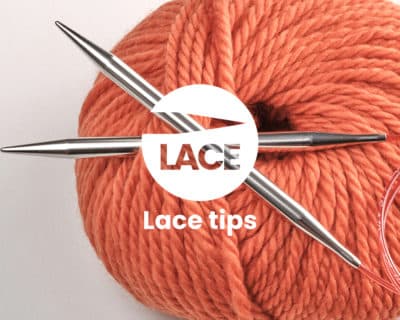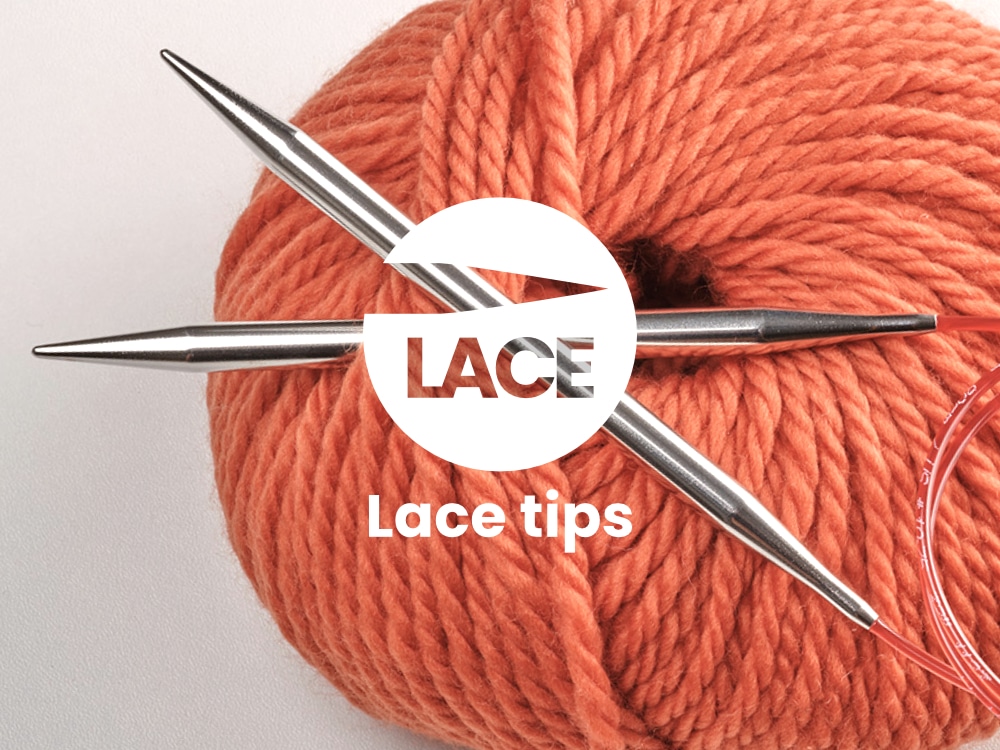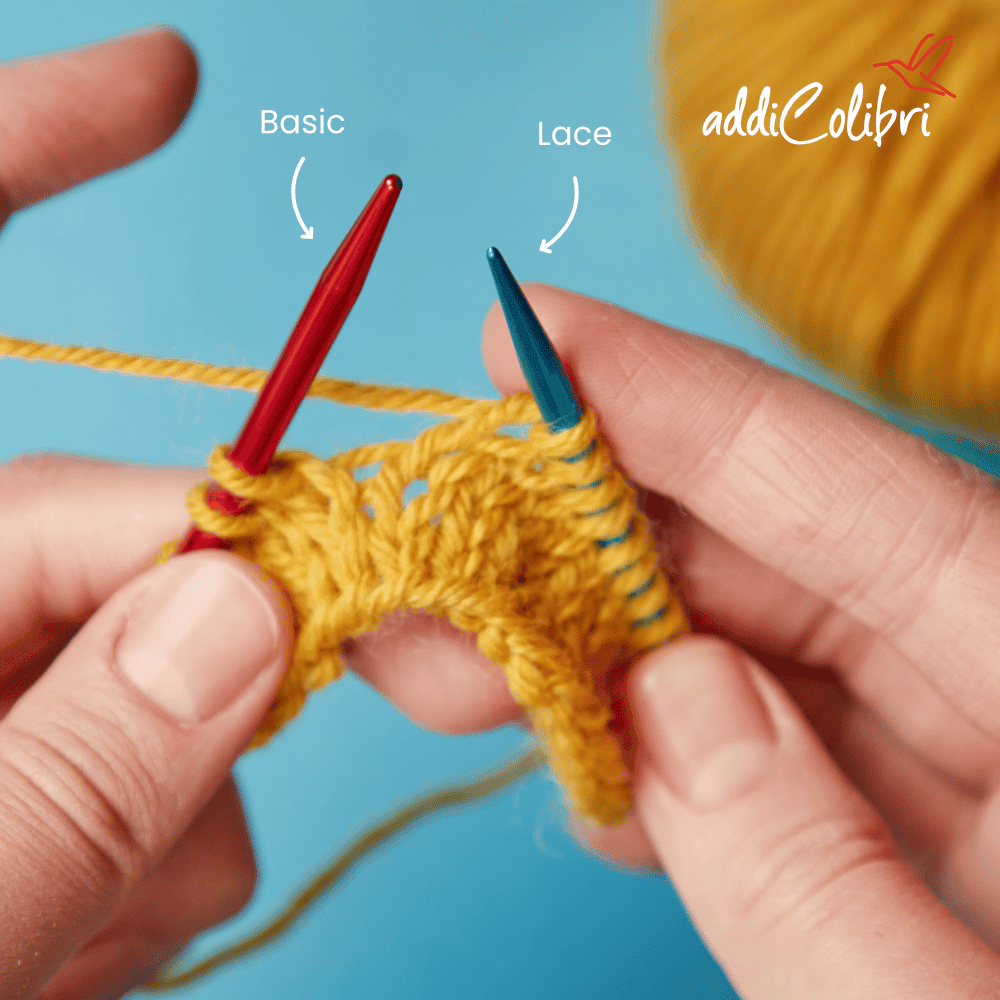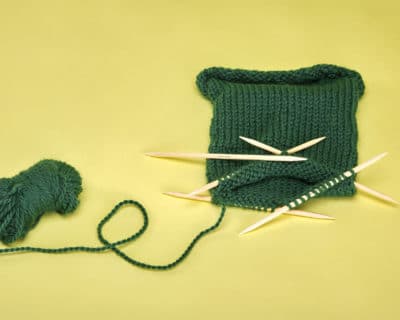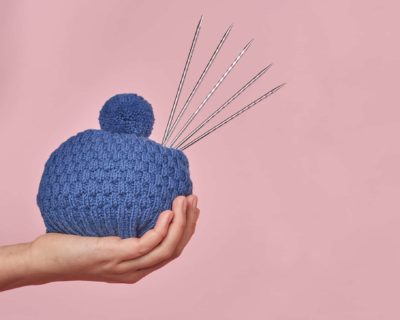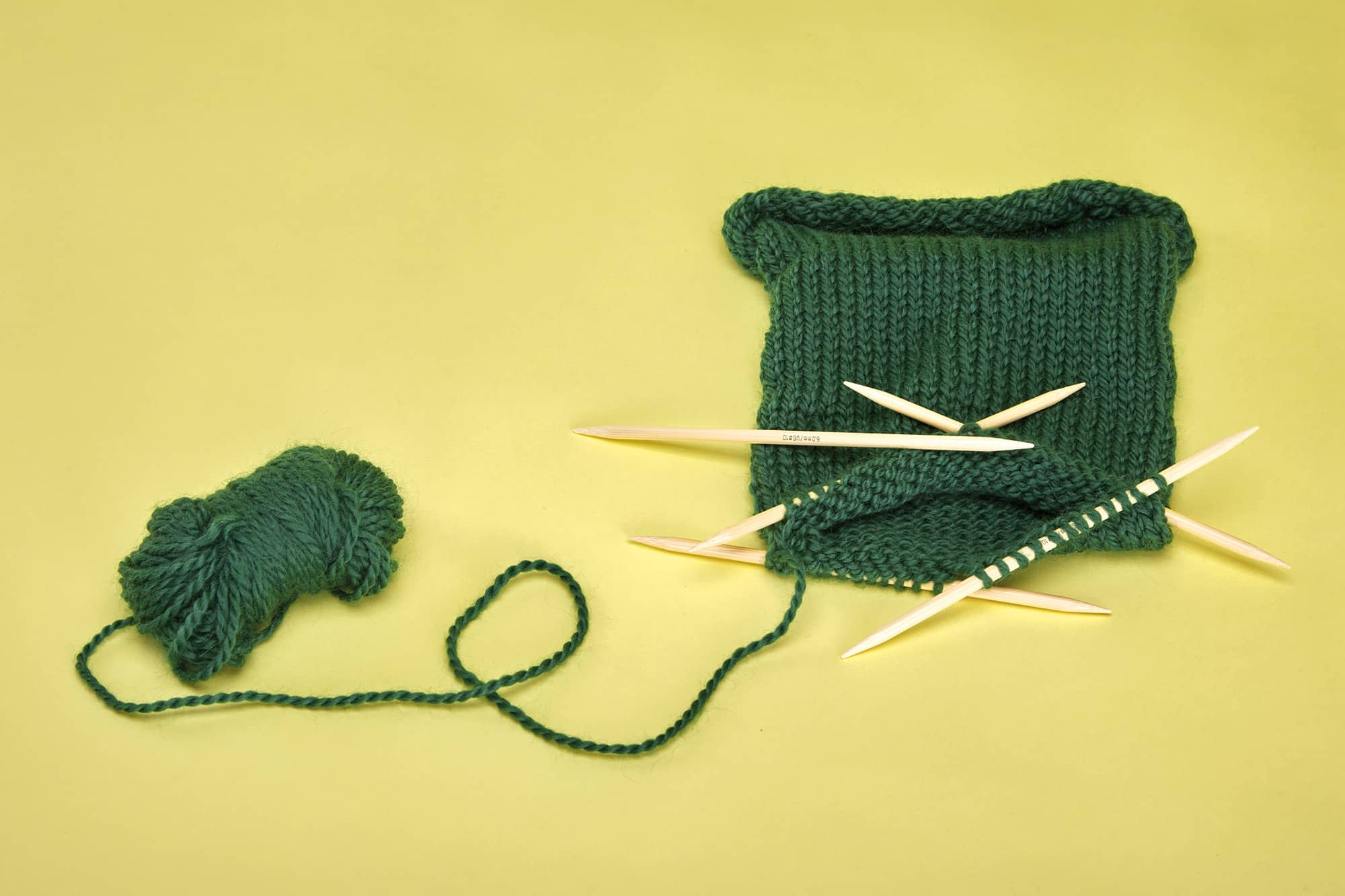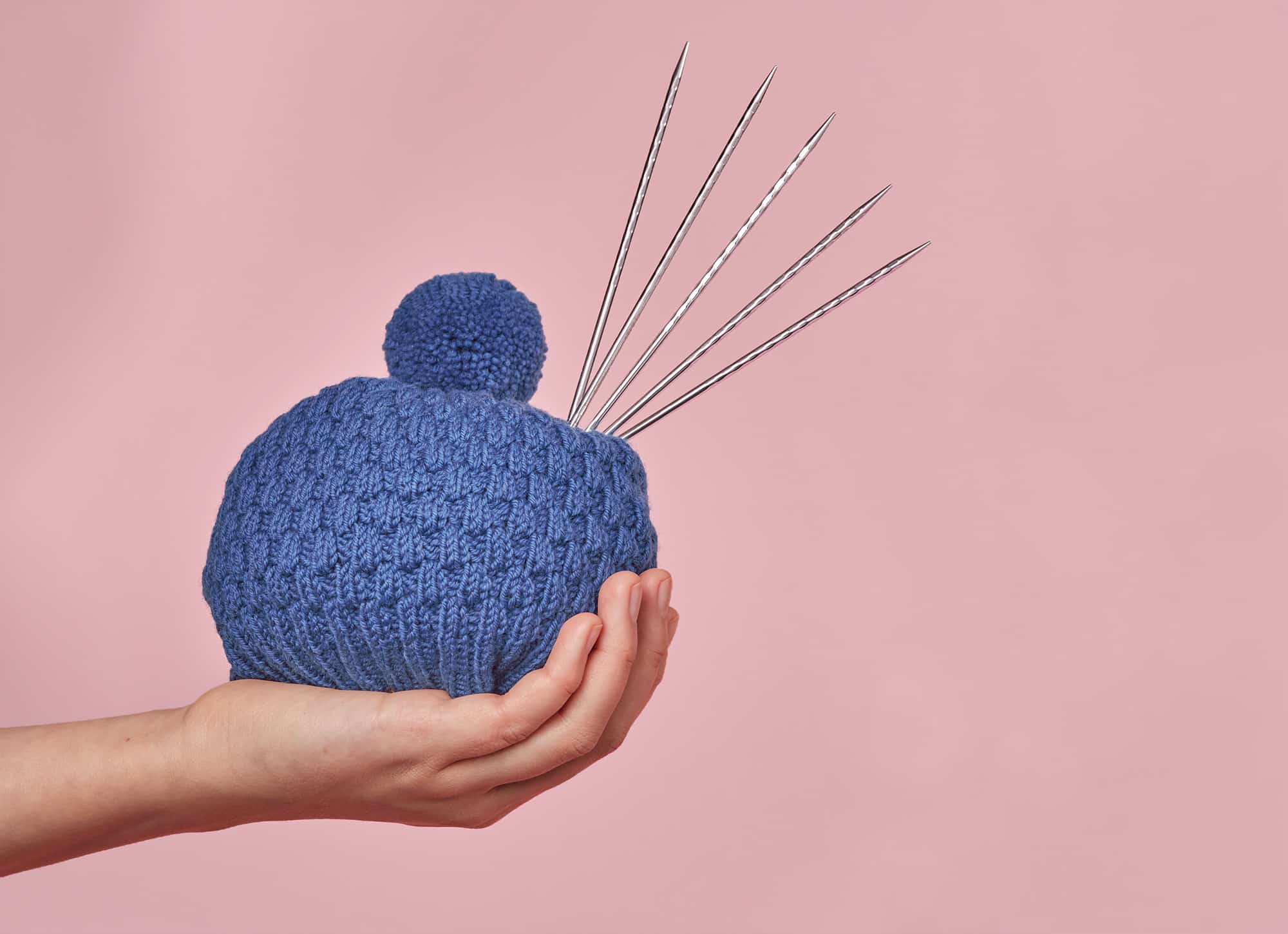Knitting socks with double pointed needles?
Do you prefer to knit socks the classic way with double pointed needles or with Sockwonder, Trio or circular knitting needles with magic loop?
As different as the techniques and double pointed needles for knitting socks are, so are the preferences. We explain the advantages and disadvantages of the different types of knitting needles for different techniques.
This article is about DPN.

The classic double pointed needles
A Double pointed needles, also known as sock knitting needles, is a set consisting of 5 rigid needles with two tips. It is used to knit mainly small diameters such as socks, cuffs, mittens or sleeves in the round.
Double pointed needles are available in different lengths and made from a variety of different materials, such as bamboo, aluminium, steel or plastic, so there is a suitable material for every knitting project and every preference.
The choice of suitable needles depends on how big your hands are, how you hold your knitting needles, which yarn you are knitting with, etc.
Knitting socks with double pointed needles - who is a double pointed needles particularly suitable for?
- For DPN pros - Once you've got the hang of it and found your personal favourite double pointed needles, you can knit socks and cuffs in null Komma nichts.
- For the small budget - Double pointed needles are generally relatively easy to produce and therefore much cheaper to buy than an addiCraSyTrio, for example.
- For tightly knitters - those who knit extremely tightly will find it easier to slide the stitches on an evenly shaped and smooth needle and knitting is particularly pleasant with fine lace laces.
Some people love it, others hate it... Those who have been knitting socks with double pointed needles for a long time don't want to use anything else, but some people are also at war with double pointed needles because the 5 needles are not always easy to handle and there are four needle transitions in the knitted piece.

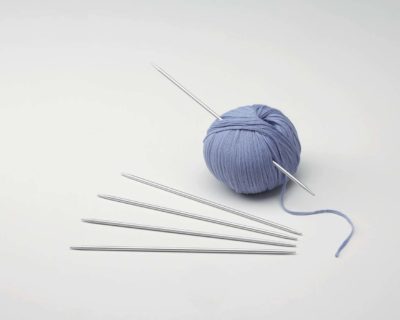

Knitting socks with double pointed needles - who is a double pointed needles particularly suitable for?
- For DPN pros - Once you've got the hang of it and found your personal favourite double pointed needles, you can knit socks and cuffs in null Komma nichts.
- For the small budget - Double pointed needles are generally relatively easy to produce and therefore much cheaper to buy than an addiCraSyTrio, for example.
- For tightly knitters - those who knit extremely tightly will find it easier to slide the stitches on an evenly shaped and smooth needle and knitting is particularly pleasant with fine lace laces.
Some people love it, others hate it... Those who have been knitting socks with double pointed needles for a long time don't want to use anything else, but some people are also at war with double pointed needles because the 5 needles are not always easy to handle and there are four needle transitions in the knitted piece.
Sylvie Rasch explains the difference between double pointed needles and addiCraSyTrio (german):
What alternatives are there to knitting socks with double pointed needles?
The addiCraSyTrio - a revolution in circular knitting.
"I don't knit socks because 5 needles are too much for my hands" - this sentence no longer applies since the introduction of the addiCraSyTrio needles.
The flexible double pointed needles consist of just three needles: two for knitting and one for knitting off. That's all there is to it. Perfect for beginners or knitters who can no longer hold the double pointed needles firmly. Learn more.
The addiSockwonder - the mini circular knitting needle
A circular knitting needle also works in very short lengths for socks. The only difficulty: the needle tips have to be very short to form a round and you still have to be able to hold them. This is how the Sockwonder with tips of different lengths was created.
On one side very short for knitting, on the other side longer for holding and all with a total length of 25 cm. Learn more.
The classic circular knitting needle
Variant 1: Half of the stitches are distributed on each of 2 circular needles and knitted off with the second needle.


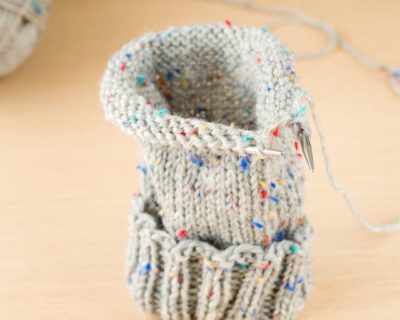
What alternatives are there to knitting socks with double pointed needles?
The addiCraSyTrio - a revolution in circular knitting.
"I don't knit socks because 5 needles are too much for my hands" - this sentence no longer applies since the introduction of the addiCraSyTrio needles.
The flexible double pointed needles consist of just three needles: two for knitting and one for knitting off. That's all there is to it. Perfect for beginners or knitters who can no longer hold the double pointed needles firmly. Learn more.
The addiSockwonder - the mini circular knitting needle
A circular knitting needle also works in very short lengths for socks. The only difficulty: the needle tips have to be very short to form a round and you still have to be able to hold them. This is how the Sockwonder with tips of different lengths was created.
On one side very short for knitting, on the other side longer for holding and all with a total length of 25 cm. Learn more.
The classic circular knitting needle
Variant 1: Half of the stitches are distributed on each of 2 circular needles and knitted off with the second needle.
Which DPN matches my hands and my project best?
Choosing the appropriate needle size and material depends on the desired knitting technique and yarn. Finer yarns require thinner needles, while thicker yarns require larger needles.
Not every yarn knits well with every needle material. This has to do with the nature of different material fibres. For example, one yarn may glide effortlessly on bamboo needles, while another may stop easily on these needles.
For relaxed knitting, the material of the knitting needle should be matched to the yarn.
Depending on the yarn material, the rule of thumb applies:
- Rough fiber = smooth needle
- Smooth fiber = rough needle
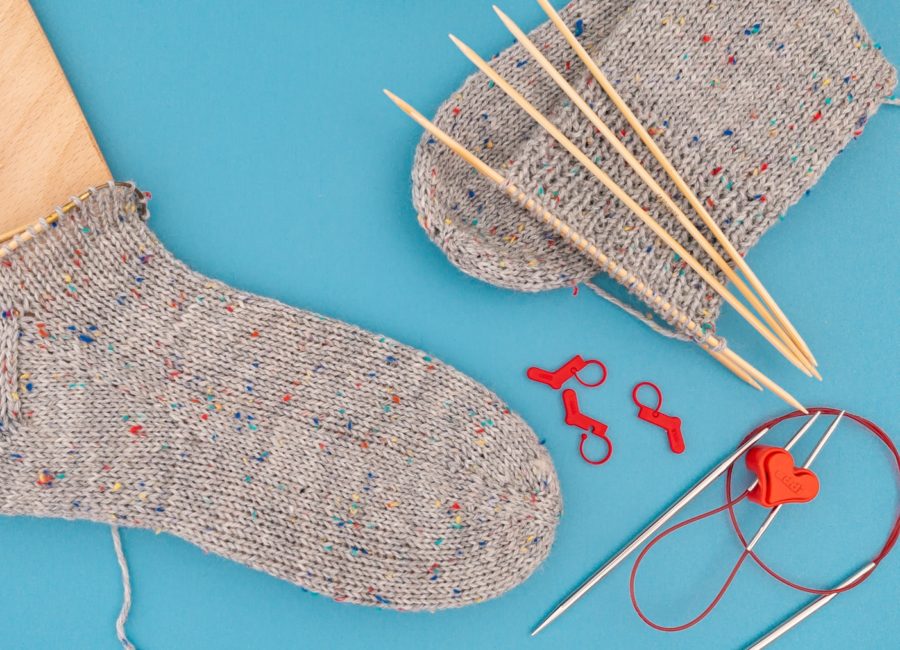
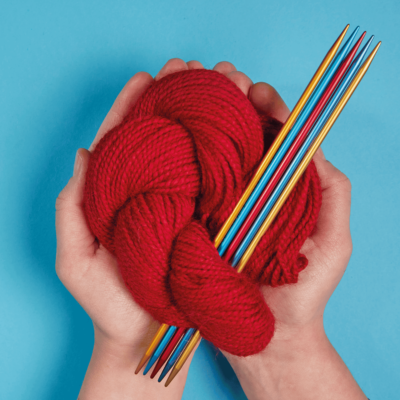
Which DPN matches my hands and my project best?
Choosing the appropriate needle size and material depends on the desired knitting technique and yarn. Finer yarns require thinner needles, while thicker yarns require larger needles.
Not every yarn knits well with every needle material. This has to do with the nature of different material fibres. For example, one yarn may glide effortlessly on bamboo needles, while another may stop easily on these needles.
For relaxed knitting, the material of the knitting needle should be matched to the yarn.
Depending on the yarn material, the rule of thumb applies:
- Rough fiber = smooth needle
- Smooth fiber = rough needle
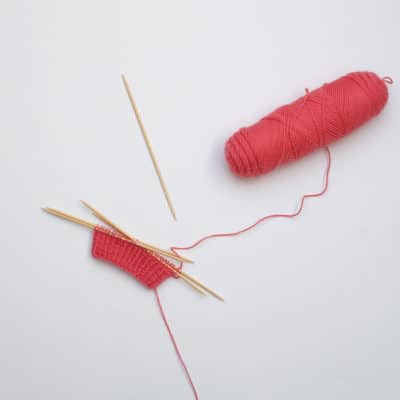
The same needle does not fit every hand
addi offers double-pointed needles in lengths from 10 cm (addiSock) to the usual sizes of 15 cm and 20 cm, as well as extra-long 40 cm needles (addiSock), which can be used as an alternative to circular needles for knitting large diameters in the round on double-pointed needles.
For knitting socks with double pointed needles, 15 or 20 cm needles are usually used, as these offer enough space for the stitches of a sock.
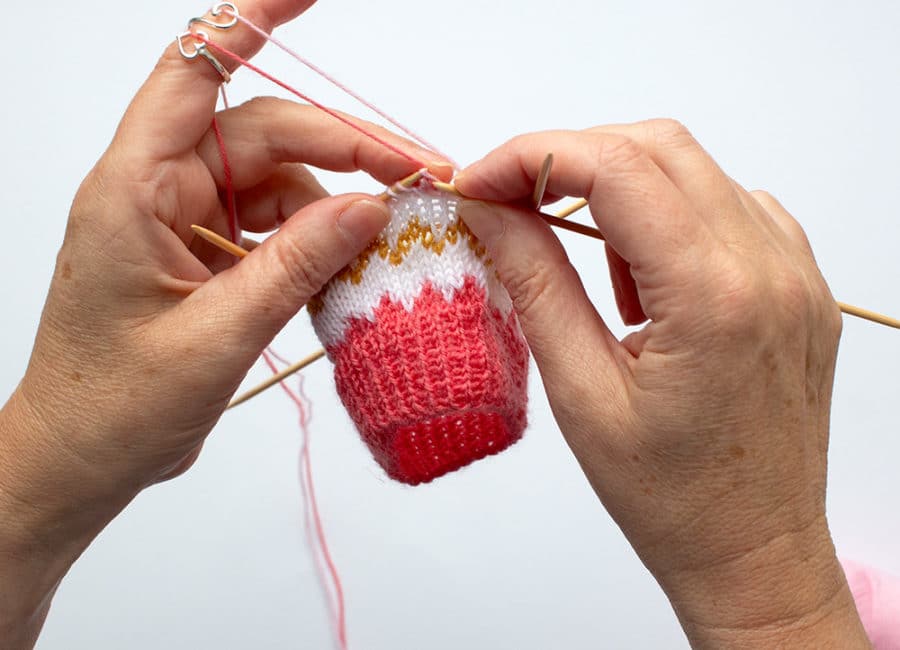
The same needle does not fit every hand
addi offers double-pointed needles in lengths from 10 cm (addiSock) to the usual sizes of 15 cm and 20 cm, as well as extra-long 40 cm needles (addiSock), which can be used as an alternative to circular needles for knitting large diameters in the round on double-pointed needles.
For knitting socks with double pointed needles, 15 or 20 cm needles are usually used, as these offer enough space for the stitches of a sock.
Pros and cons 10 cm double pointed needles
Advantage:
- A 10 cm double pointed needles is particularly suitable for knitting baby socks or doll's clothes - i.e. very small diameters as well as for knitting sock tips.
- They are more suitable for small hands or for knitters who do not need a lot of needles in their hands
Disadvantages:
- The needles are too short for knitted socks for adults
- The needles can be more difficult to hold
Pros and cons 15 cm double pointed needles
Advantage:
- Die 15 cm Nadeln haben den Vorteil, dass gerade an den Übergängen zur nächsten Nadel wenig Nadelspitze „im Weg“ ist, weil die Länge der Nadeln für durchschnittliche Socken gut passt.
- Especially with smaller hands and when knitting medium-sized socks, 15 cm is completely sufficient.
Disadvantages:
- If, for example, you want to knit large men's socks (from EU size 44), the needles may be a little short for the many stitches.
- If you need a lot of needle in your hand, you will miss some length here.
Pros and cons 20 cm double pointed needles
Advantage:
- If you need a little more needle in your hand or want to knit larger socks (approx. from EU size 44), you can use double pointed needles with a length of 20 cm.
- Longer needles can also be an advantage for very loose knitters, because they do not slip out of the knitting so quickly and unattended.
Disadvantages:
- The 20 cm long needles can be too much of a hindrance for anyone who struggles with the many needles and the hand position.
Double pointed needles for beginners and loose knitters
- If you are still practising knitting or knitting particularly loosely, there is a risk of needles slipping out of the knitting unintentionally.
- To prevent this, we recommend choosing a rougher needle material such as bamboo (addiNature Bamboo) or our structured Novel DPNbecause the structure holds the knitted fabric in place better. Our particularly lightweight addiColibri Double pointed needles do not slip out of the knitting so quickly as they have a matt surface.
- Longer needles (20 cm) can be an advantage for very loose knitters, as they do not slip out of the knitting as quickly due to the extra length.
- However, the longer tips can also get blocking the transition for beginners and make knitting at the transitions more difficult.
Double pointed needles for tightly knitters
- If you knit very tightly, you should choose a material that is as smooth as possible and on which the stitches slip easily, such as aluminium (addiColibri) or particularly strong in thin thicknesses of steel (addiSteel).
- A length of 15 cm is sufficient for a medium-sized sock, as the needles are held firmly by the knitted fabric.
- A particularly pointed lace tip can help inserting and knitting off tight stitches, such as our addiColibri do.
- Do you exert a lot of pressure when knitting and do you like to bend your needles? Then it is also advisable to choose a metal needle that either adapts to the shape of your hand without breaking (aluminium like addiSock or addiColibri) or they choose a material that is difficult to bend like steel (addiSteel).
All double pointed needles from the addi range with their respective special features and properties can be found in the following element to click through and compare:
Double pointed needles with lace or basic lace?
Are you more of a lace or basic tip type?
"Basic" stands for our standard needle tips, which are rather rounded and are particularly suitable, for example, if you knit multi-threaded yarns, are a beginner or knit loosely.
With only slightly twisted yarns, the round tips mean there is no danger of accidentally picking "into" the yarn instead of behind it. Especially as a beginner or if you knit particularly loosely, this is especially pleasant while working.

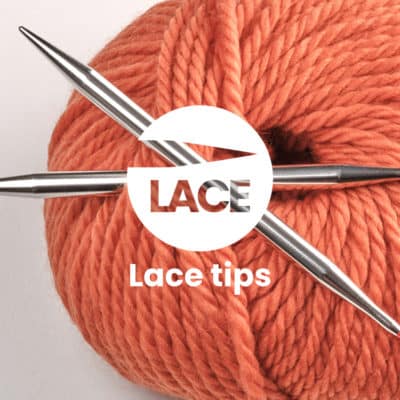
Double pointed needles with lace or basic lace?
Are you more of a lace or basic tip type?
"Basic" stands for our standard needle tips, which are rather rounded and are particularly suitable, for example, if you knit multi-threaded yarns, are a beginner or knit loosely.
With only slightly twisted yarns, the round tips mean there is no danger of accidentally picking "into" the yarn instead of behind it. Especially as a beginner or if you knit particularly loosely, this is especially pleasant while working.
"Lace" stands for particularly long and fine tip, which is especially appreciated when knitting very fine yarns, when knitting several stitches together for sophisticated patterns or by knitters with a tight gauge.
Due to the long narrow shape of the tips, it is easy to insert into a stitch, even if the stitch is tight.
This makes it easy to knit even multi-threaded, with ajour patterns or tight stitches, and there is no danger of not picking up a stitch correctly.
Tip: Can't make up your mind? Then simply choose the addiColibri. The double pointed needles have a lace and a basic tip. So you have the right needle for every yarn - light as a feather, colourful and suitable for almost any yarn.
Overview of the double pointed needles range:
- addiSteel
- Steel (white bronzed)
- 20 cm 1,25-3 mm
- Basic tips
- Steel (white bronzed)
- addiSock
- Aluminium pearl grey anodised
- 10, 20, 23, 40 cm, 2-8 mm
- Basic tips
- addiColibri
- aluminium colour anodized
- 15, 20, 23 cm, 2-8 mm,
- Lace + Basic tips
- addiMystic Sock
- aluminium colour anodized
- 15, 20, 23 cm, 2-6 mm
- Lace tips extra fine
- addiCraSySnake
- Aluminium pearl grey anodised
- 15 cm, 2-3,5 mm
- Lace tips extra fine
- addiNovel Quintett
- Messing weißbronziert mit Novel-Struktur
- 20, 23 cm, 2-6 mm
- Lace tips
- addiNature Bamboo
- Bambus gewachst
- 15, 20 cm, 2-10 mm
- Basic tips
- addiChampagne
- Plastic with gold glitter
- 20, 25 cm, 7-20 mm
- Basic tips
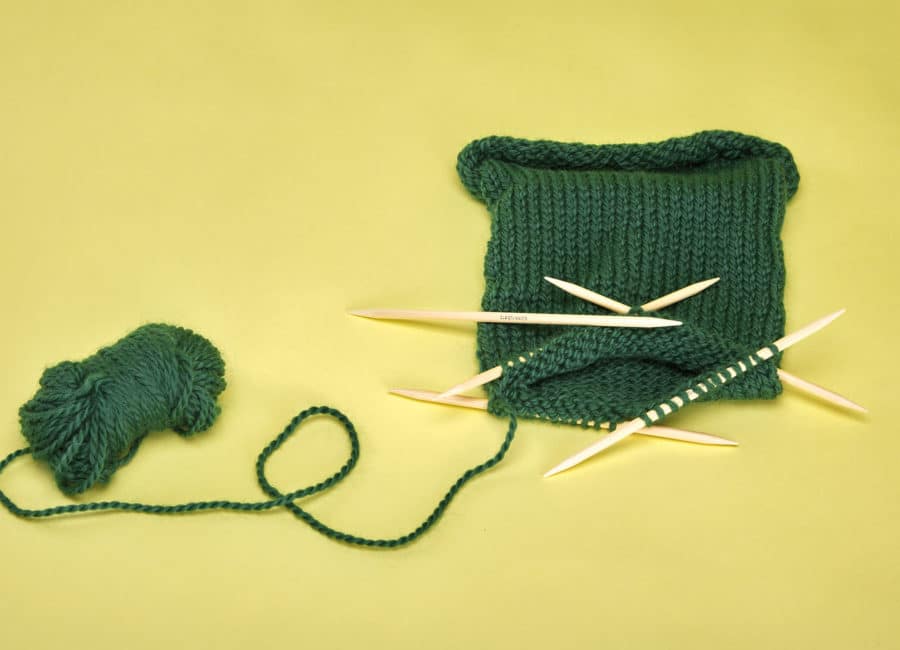
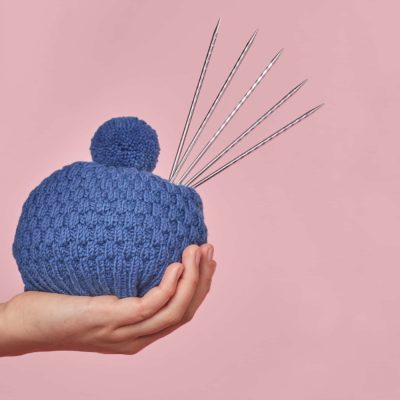
Overview of the double pointed needles range:
- addiSteel
- Steel (white bronzed)
- 20 cm 1,25-3 mm
- Basic tips
- Steel (white bronzed)
- addiSock
- Aluminium pearl grey anodised
- 10, 20, 23, 40 cm, 2-8 mm
- Basic tips
- addiColibri
- aluminium colour anodized
- 15, 20, 23 cm, 2-8 mm,
- Lace + Basic tips
- addiMystic Sock
- aluminium colour anodized
- 15, 20, 23 cm, 2-6 mm
- Lace tips extra fine
- addiCraSySnake
- Aluminium pearl grey anodised
- 15 cm, 2-3,5 mm
- Lace tips extra fine
- addiNovel Quintett
- Messing weißbronziert mit Novel-Struktur
- 20, 23 cm, 2-6 mm
- Lace tips
- addiNature Bamboo
- Bambus gewachst
- 15, 20 cm, 2-10 mm
- Basic tips
- addiChampagne
- Plastic with gold glitter
- 20, 25 cm, 7-20 mm
- Basic tips
